There is a wide number of butterflies in the United States that have orange and black colors, markings, and patterns, which makes identifying them a little difficult.
We have listed the most common black and orange butterflies that you may come across.
Table of Contents
1. Monarch
The Monarch butterfly (Danaus plexippus) is often referred to as the Monarch and is a milkweed butterfly. It is the most familiar butterfly in North America and is a pollinator species.
It is easily recognizable with its black, white, and orange pattern and a wing span of up to 10.2cm.
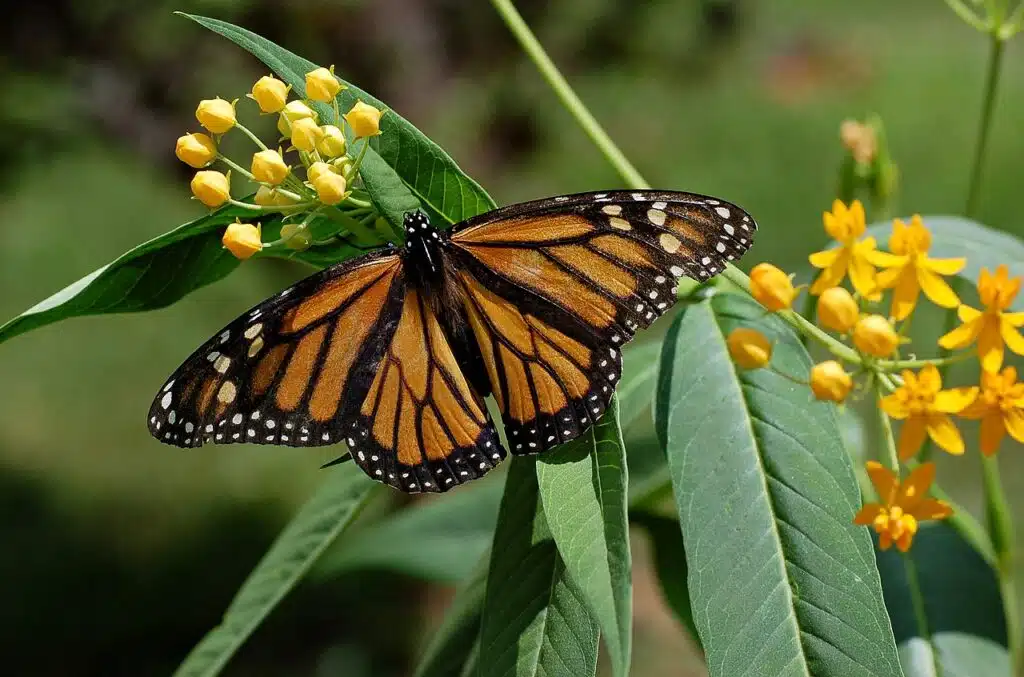
This butterfly is often found in forests and mountain areas and they go through an interesting migratory pattern, where they can travel up to 2,800 miles or more to central Mexico to find the right climate to start their hibernation.
They hibernate and metamorphosis. They have two pairs of orange/red wings with black veins and white spots. The males are slightly bigger than females with black dots on their wing veins. Their lifespan as a butterfly is only five weeks.
2. Gulf Fritillary
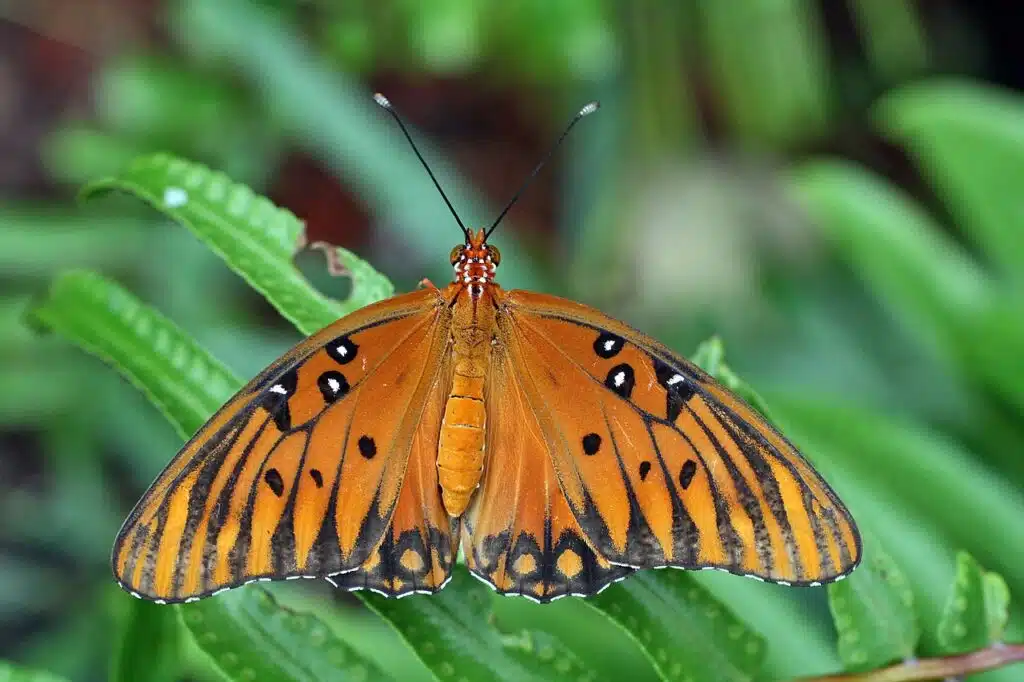
The Gult Fritillary or Passion Butterfly (Dione vanillae) is bright orange and is common in the Southern United States, usually seen in Florida and Texas. When they are seen by a predator, they release a chemical, which has a bad odor, which is why predators tend to stay away from this species.
This species can be identified by their bright orange wings with black marketings and three white dots, which have black circles around them on the fore wings. Underneath, they are brown. Their wingspans can reach up to 9.5cm.
They are common throughout the year in Southern Texas and Florida and from January to November in the north. They are common in open fields, pastures, subtropical forests, and city gardens.
3. Pearl Crescent
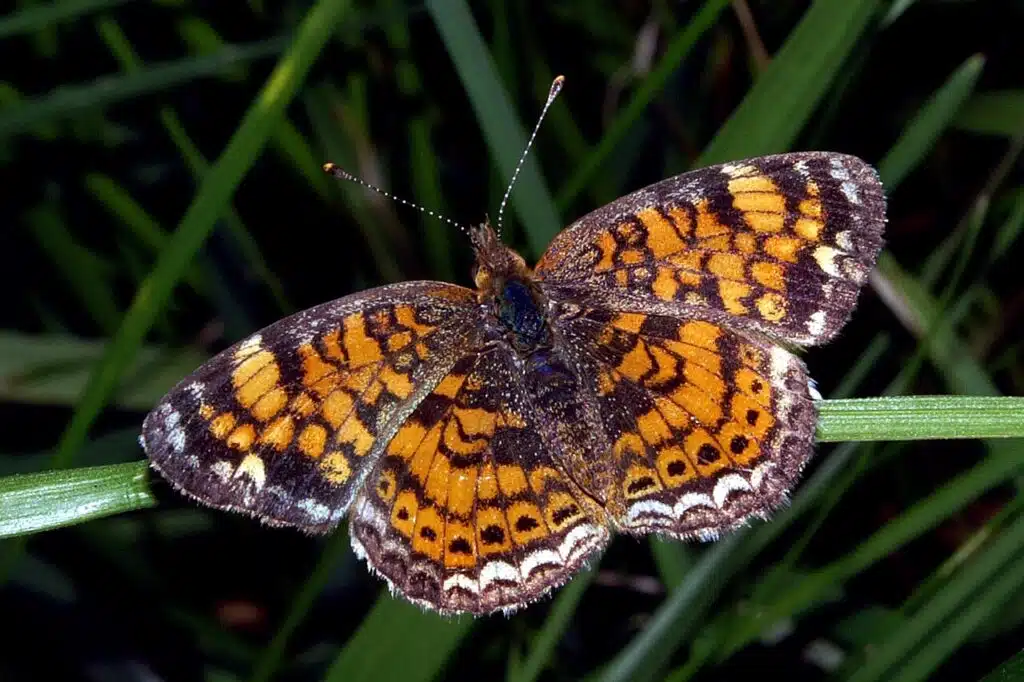
The Pearl Crescent Butterfly (Phyciodes tharos) is a North American butterfly that is encountered throughout the United States, but never on the west coast. They are common in fields, open pine woods, road edges, and pastures.
They have a varied pattern with males having black antenna knobs with an orange upper side with black borders. They can grow to 34mm in wing span. They feed on the nectar of a variety of flowers.
4. Red Admiral
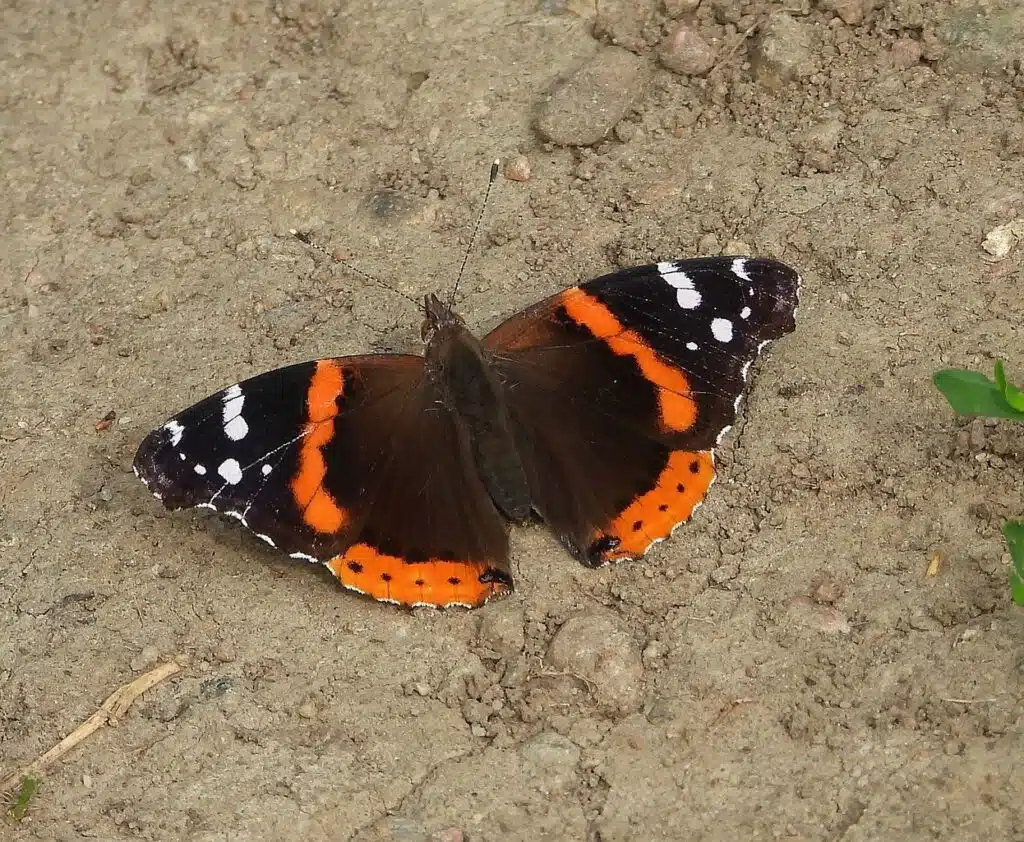
The Red Admiral (Vanessa atalanta) is a strong flying and large butterfly that is commonly seen in gardens. They are often seen in gardens, where they feed on the nectar of flowering ivy and sometimes even rotting fruits.
These butterflies have grown in population over the years. Their wing span can reach 7.2cm. On the upper side, the Red Admiral is black with white spots and an orange band on both the front and back wings. They are less colorful and smaller during winter and grow brighter and bigger during the summer months.
They are very erratic at how they fly. Males are often seen on ridge tops in the afternoon as they wait for females to lay eggs on the host plants. You are more likely to see these butterflies from March to October in the North and October to March in the south.
As adults, they feed on tree sap, fermenting fruit, and bird droppings, while they also feed on nectar from alfalfa, red clover, and milkweed. They are common in woods, yards, marshes, fields, and parks.
Further Reading:
5. Painted Lady
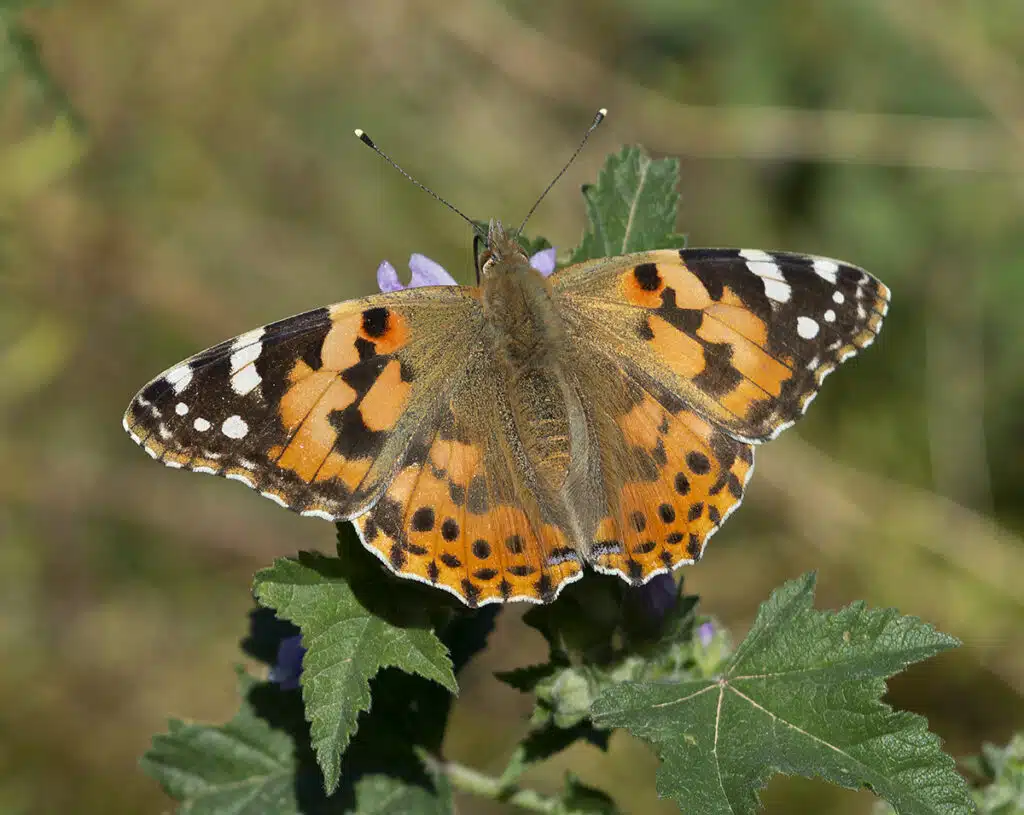
The Painted Lady (Vanessa cardui) is a very common butterfly in the United States. They are ground color to orange on the upper side with black and white. The front wings are black and irregular in shape, while the back wing has a black patch. Their wing span can be up to 7.3cm.
You are likely to see these butterflies from May to October in the East and October to April in the south. As adults, they feed on thistles, cosmos, joe pye weed, and more that are at least three to six feet in height. They can be found just about anywhere including in urban gardens, old fields, they can also be found in dunes.
6. Fiery Skipper
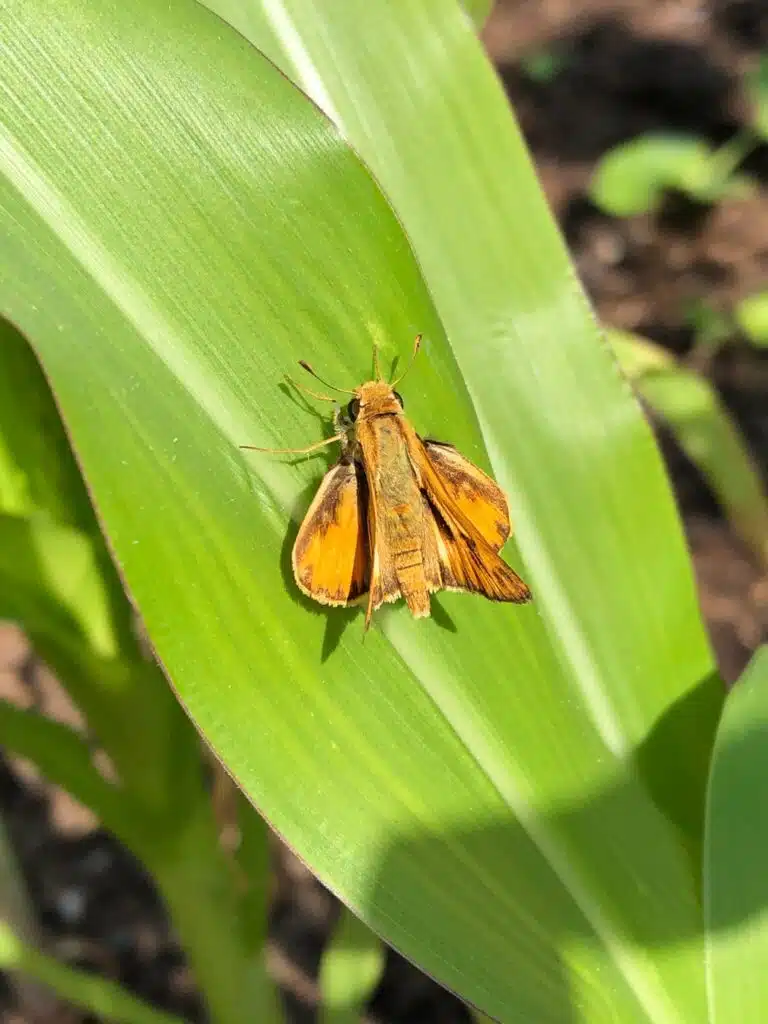
This butterfly (Hylephila phyleus) was first described in 1773 and can grow to 2.5cm in length. Males are orange or yellow and females are dark brown. There are small brown spots that may be seen on the front and back wings of both the male and female.
The caterpillars of the fiery skipper are green to a pink gray with black heads. They are often seen as pests. The adults have short antennae with the males having small black spots under their back wings. Females have an irregular orange band on their dark brown wings.
You are likely to see the fiery skipper flying around from May to August in the north and throughout the year in Southern Texas and Florida, where they feed on the nectar of a variety of plants including thistles and swamp milkweed.
7. American Lady
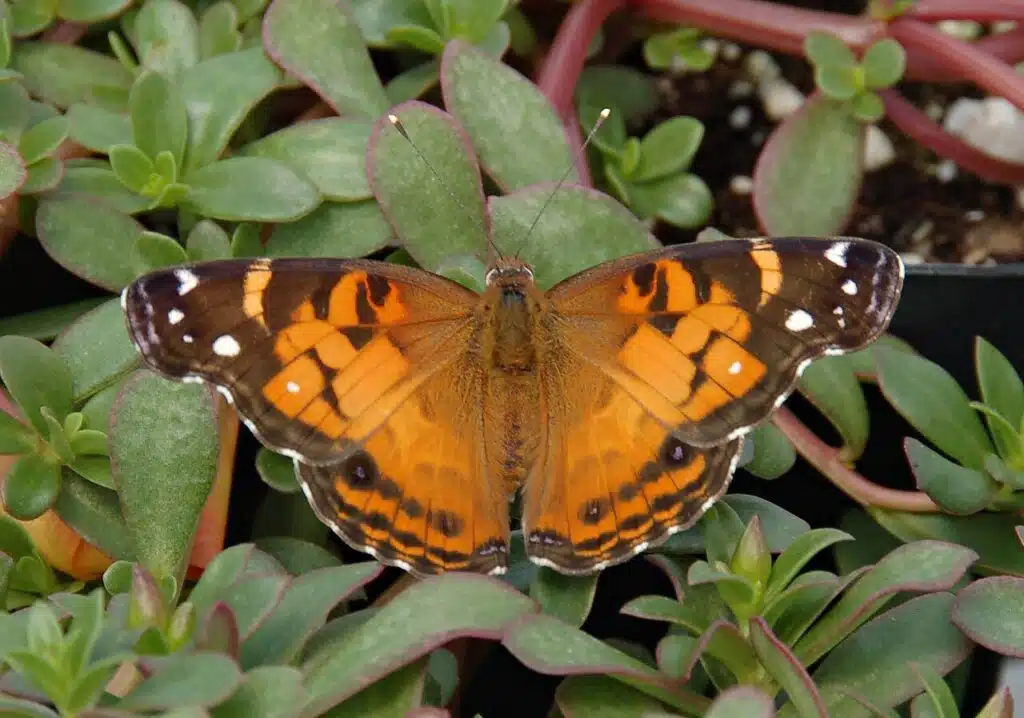
The American Lady (Vanessa virginiensis) is a beautiful butterfly that grows to 6.6cm in wing span. They are brown or yellow with an orange pattern. They have a black patch on their front wings with a small white dot in the orange area and a white bar. They are larger and brighter during the summer months.
The caterpillar of this species varies in color from green/yellow to dark colors. They feed on their own on host plants. These butterflies are most common from May to November and all year round in the Deep South and Southern Texas.
The adult butterflies feed mostly on sunflower plants, goldenrod, marigolds, and common milkweeds. They inhabit open spaces where there is low vegetation, which includes parks, forest edges, and meadows.
8. Queen
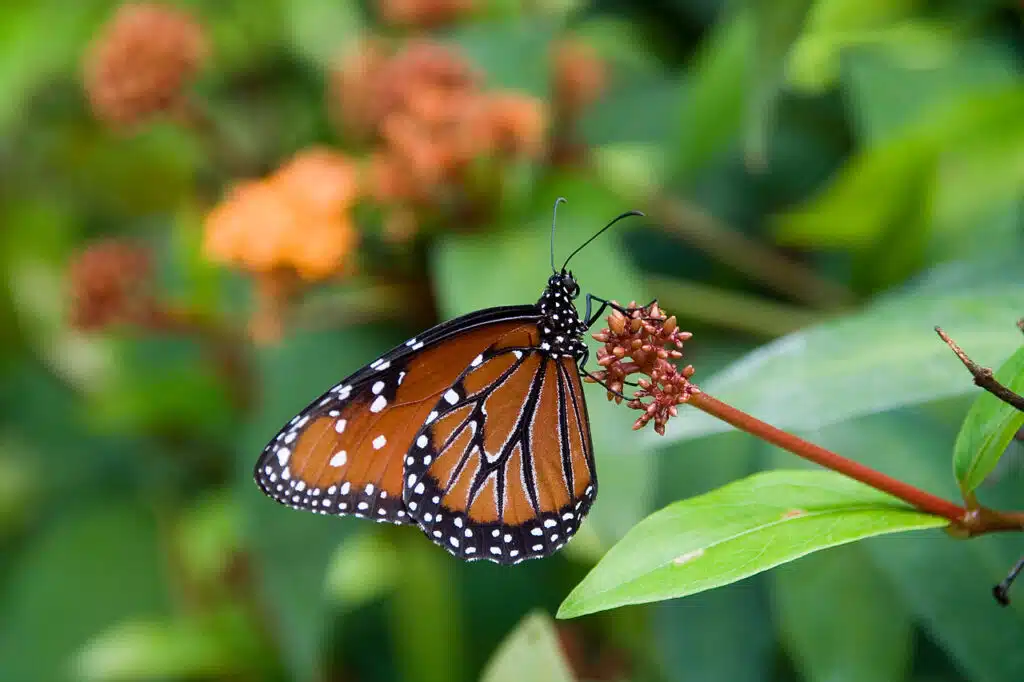
Queen butterflies (Danaus gilippus) are common in North America growing up to 8.5cm in wing span. These orange or brown butterflies have black wing borders and small white spots on their front wings. Their back wings have black veins with small white dots surrounded by a black border.
They are common in meadows, marshes, desserts, forest edges, and fields. The female lays only one egg at a time in a host plant, which the larvae use as food. As adults, they feed on flower nectar.
The males search for a perfect female during the day, mating up to fifteen times.
9. Variegated Fritillary
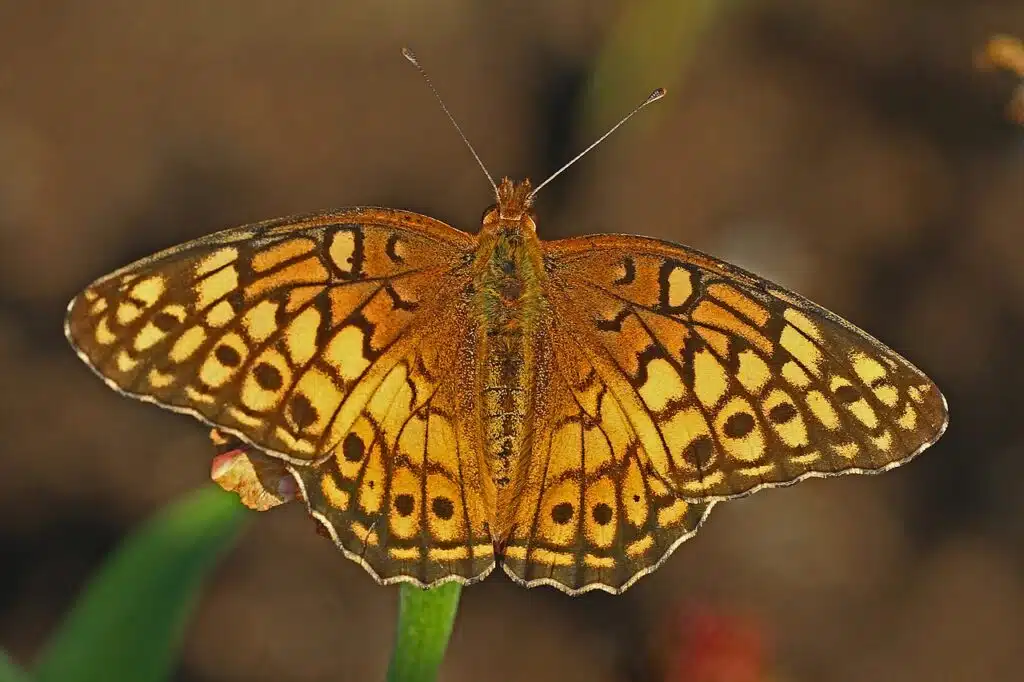
The Variegated Fritillary (Euptoieta claudia) can be found in North and South America. They use passionflowers as their host plant. They fly low to the ground and fast, often resting or eating the nectar from flowers as they go.
Their wings are black and orange checkered patterns with a row of black spots and lines on the front and back wings. These butterflies can grow to an 8cm wing span. You are more likely to see them in the North from April to October and from November to December in the South.
The Variegated Fritillary feeds mostly on nectar from different plants, including peppermint, common milkweed, swamp milkweed, and tickseed sunflowers. They are commonly seen in prairies, pastures, landfills, roads, and fields where there is plenty of sunshine.
10. Great Spangled Fritillary
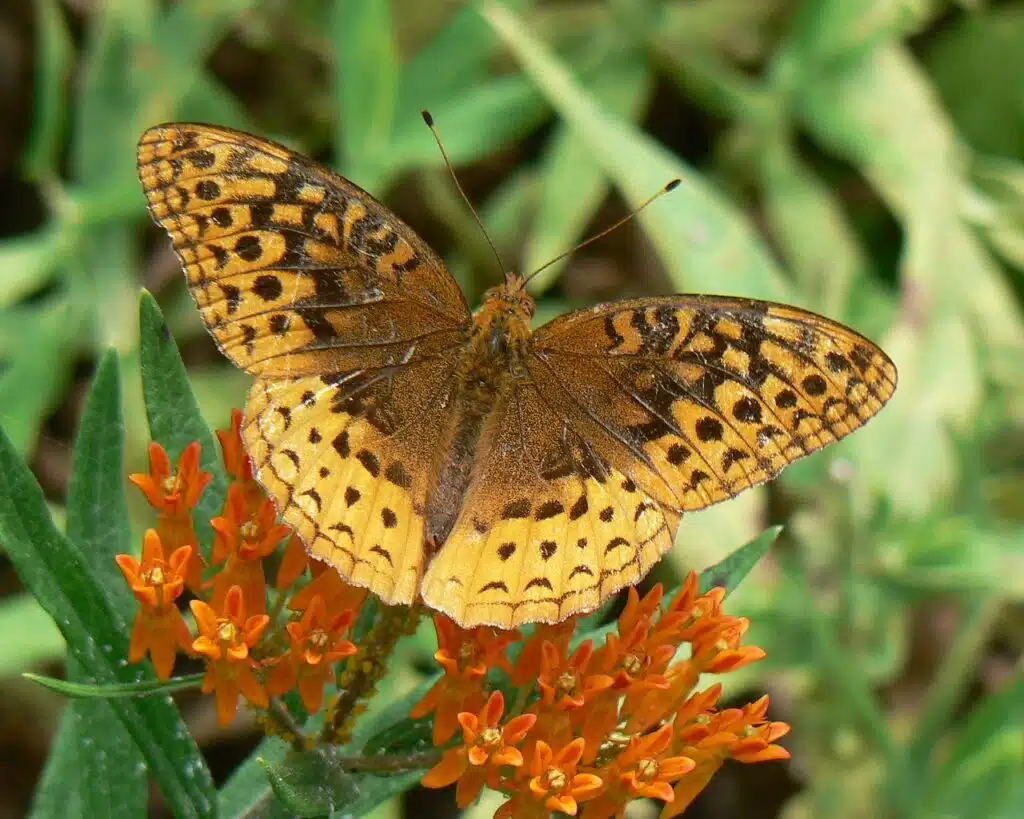
This butterfly (Speyeria cybele) can grow to 8.8cm in wing span and is easily identified by its bright orange coloration with five black dashes on the front wings and irregular black dashes on the back wings.
They are large butterflies that are most commonly seen from the middle of June to the middle of September. Adults feed on the nectar of thistles, milkweed, bergamot, red clover, and purple coneflower.
You are likely to see the Great Spangled Fritillary in open and moist areas, such as pastures, meadows, open woodlands, fields, valleys, and prairies.
11. Viceroy
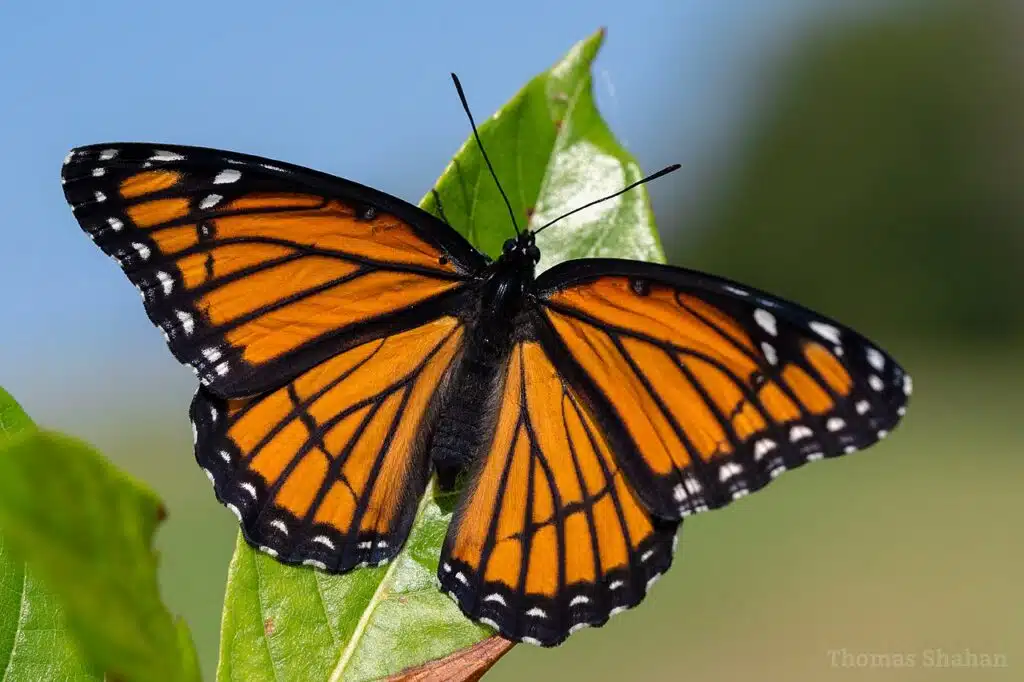
This North American butterfly (Limenitis archippus) was named in Kentucky in 1990. it has orange and black patterned wings and can grow to 8.1cm. These large butterflies are smaller than the Monarch.
They are very similar to the Queen Butterfly in Georgia and Florida, where they are often mistaken. Males spend their day perched on vegetation looking for a female. They are commonly sighted from May to September and throughout the year in Florida.
The adults feed on several flowers, including decaying fungi. They prefer shrub areas, including swamp edges, valley bottoms, roadsides, wet meadows, and lake edges.
12. Eastern Comma
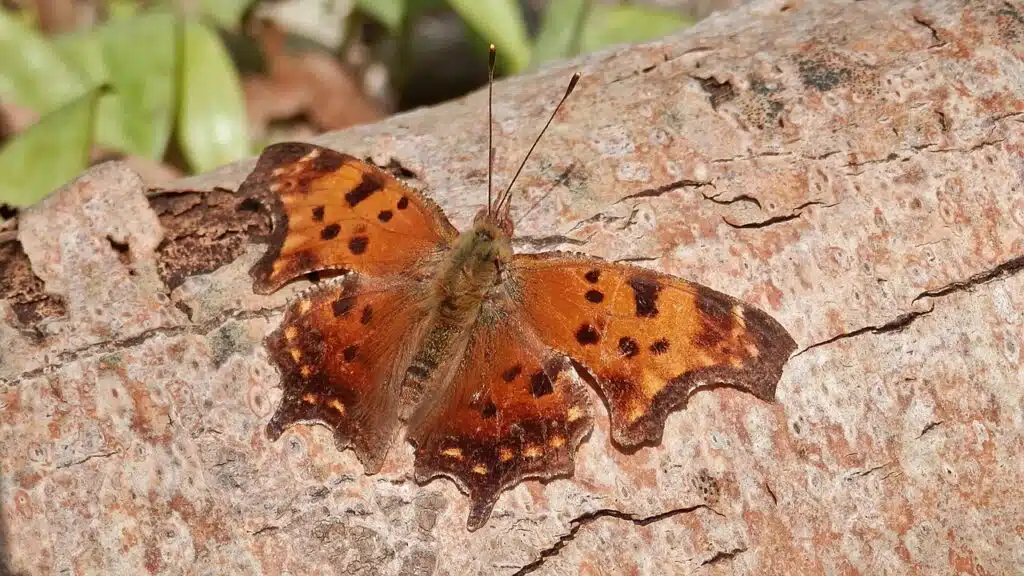
The Eastern Comma (Polygonia comma) is a butterfly endemic to North America and is variable based on the season. In summer, they have black hind wings and in winter their back wings are orange to red. They can grow to a wing span of 6.4cm.
They are often seen in marshes, swamps and rivers, and ponds, they are never far from a water source. They feed on the sap of rotting fruit along with eating the minerals and salts from dung.
The eastern comma may be spotted in woods near rivers, ponds, marshes, swamps, and other water sources. Adults fly and lay eggs in spring, through to the end of April. During summer they emerge and fly from May through to September. Adults appear from September to October and immediately seek shelter to protect them as winter approaches.
13. Tawny Emperor
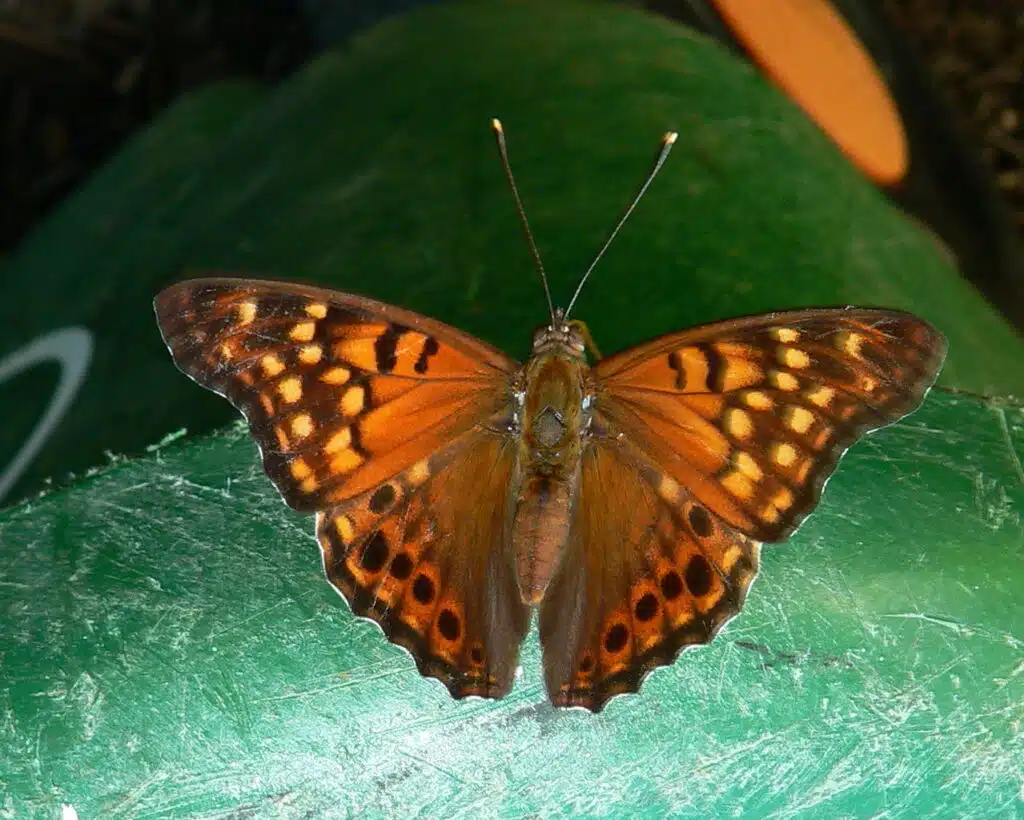
The Tawny Emperor (Asterocampa clyton) is a brush-footed butterfly, native to North America. They are mostly dark brown with orange color with pale yellow/orange spots on their fore wings. They grow to 6.6cm in wing span.
They are commonly seen close to homes, driveways, and close to water, including woodlands. As adults, they feed on the sap of plants, and dung, and sometimes they may land on a flower.
As a caterpillar, they are light green with two stripes and yellow spots. Their heads are dark with two antler-like horns. In late winter, when they are half grown, they turn brown, grouping together inside hackberry leaves.
14. Silvery Checkerspot
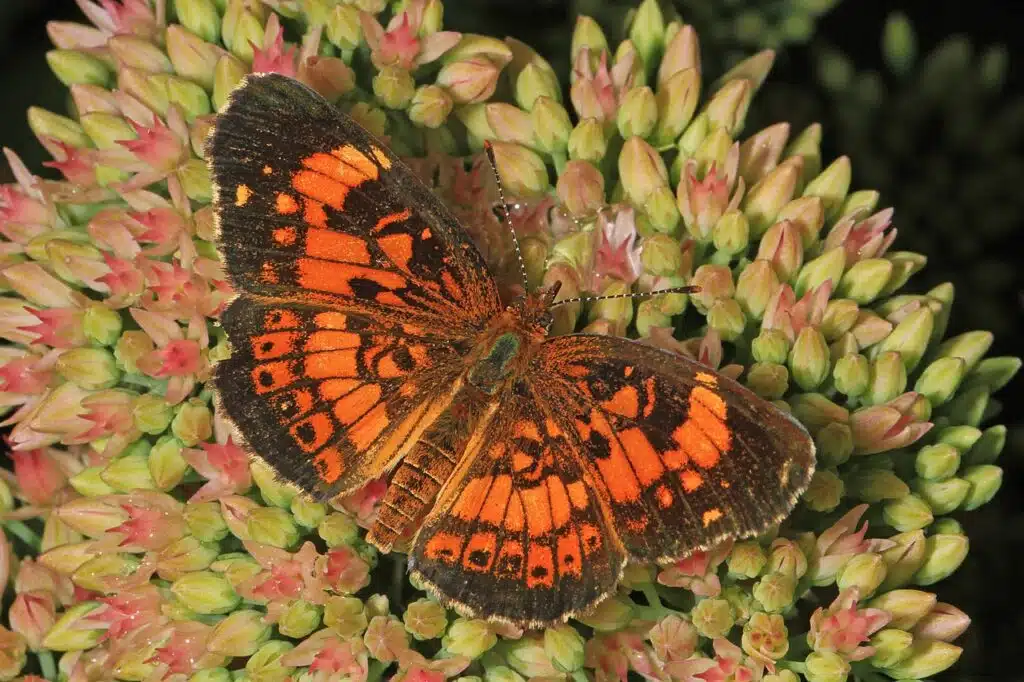
This butterfly (Chlosyne nycteis) can be seen throughout North America, though it is listed as a concern in Connecticut and Maine. They are orange with dark markings and borders. The hind wing has a white spot on both sides, while the hind wing has a white crescent.
As caterpillars they are black with white spots, sometimes you may see an orange stripe with branched spines. They can be found from southern Canada to Texas and Georgia, though they are not often encountered on the Gulf Coast Plain. They prefer moist areas and are most common in meadows, forest openings, and on the side of streams.
15. Least Skipper
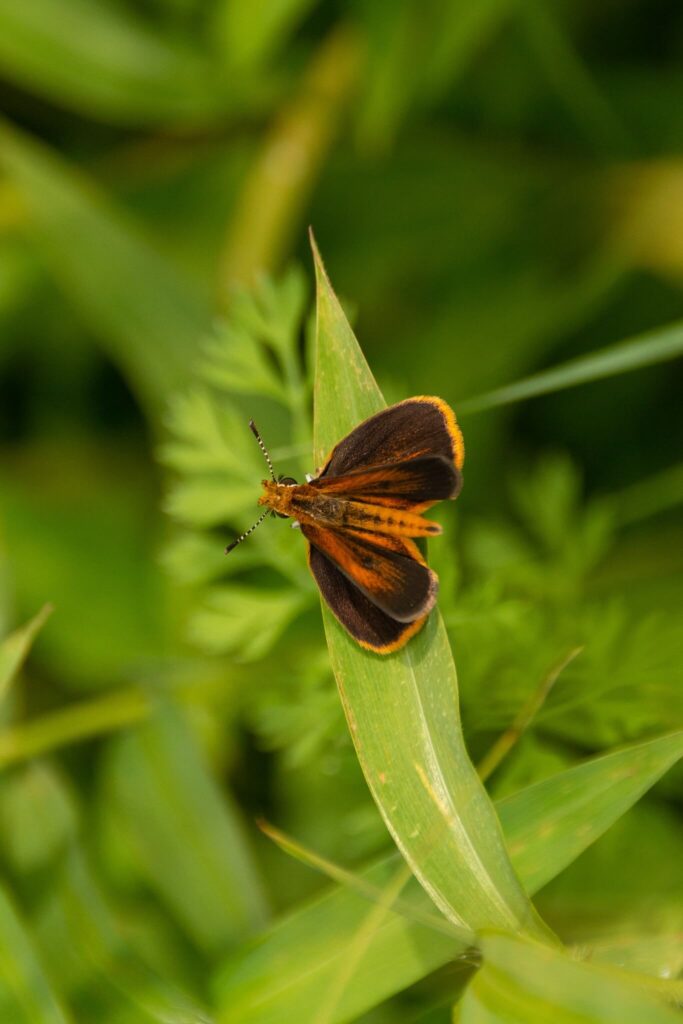
The Least Skipper (Ancyloxypha numitor) is a North American butterfly with a weak flight. They have a slender body with rounded wings and checkered antennae without any hooks. These butterflies are brown with patches of orange, with the hind wings being orange with dark brown to black bands that surround the orange.
Under the wings they are orange. They can grow to a wing span of 2.6cm. They are mostly seen in wet habitats where there is tall grass.
Adults are seen from May to September in the north and from February to December in the south. They are seen throughout the year in Southern Florida.
16. Bordered Patch
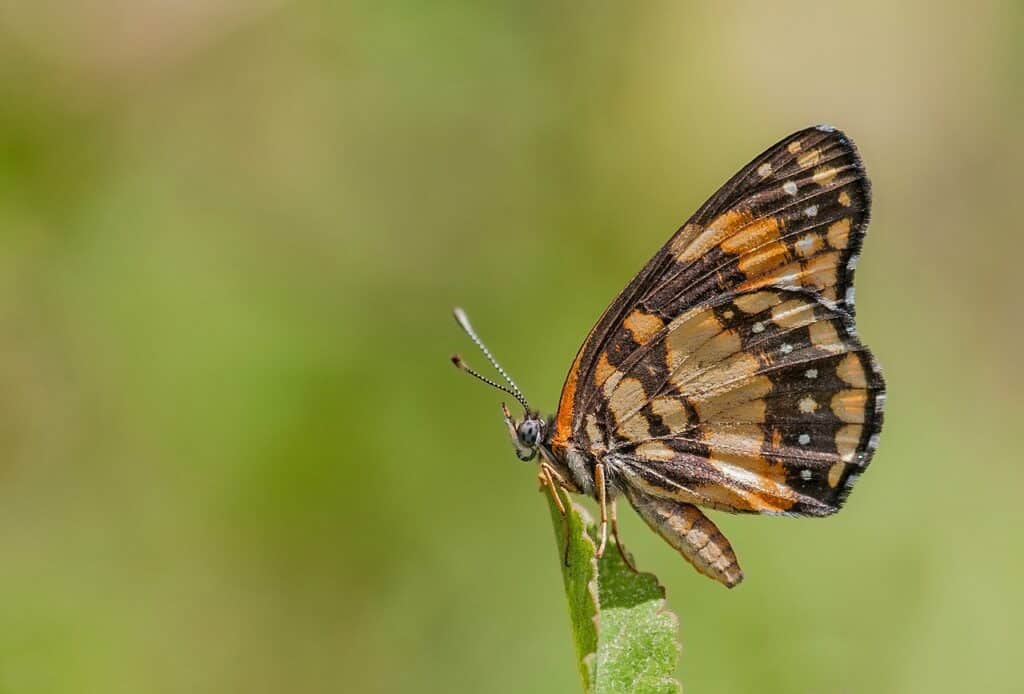
The Bordered Patch (Chlosyne lacinia), also known as the Sunflower Patch, can be found in North and South America. These butterflies are variable with wings that are mainly black with the fore wing having rows of white and yellow to orange colored spots, which vary in size.
The hind wings can vary from one butterfly to the next with some being completely black to others having spots and some white rows, others have red/orange areas. Under the wings tends to be as variable s the upper side and can vary with rows of white to orange spots.
This butterfly can grow to 4.8cm in wing span and is often seen in desert hills and woodlands in North America, though they do prefer to live in agricultural areas. They are most commonly encountered from January to November in Arizona, May to October in California and throughout the year in southern Texas.
17. Western Giant Swallowtail
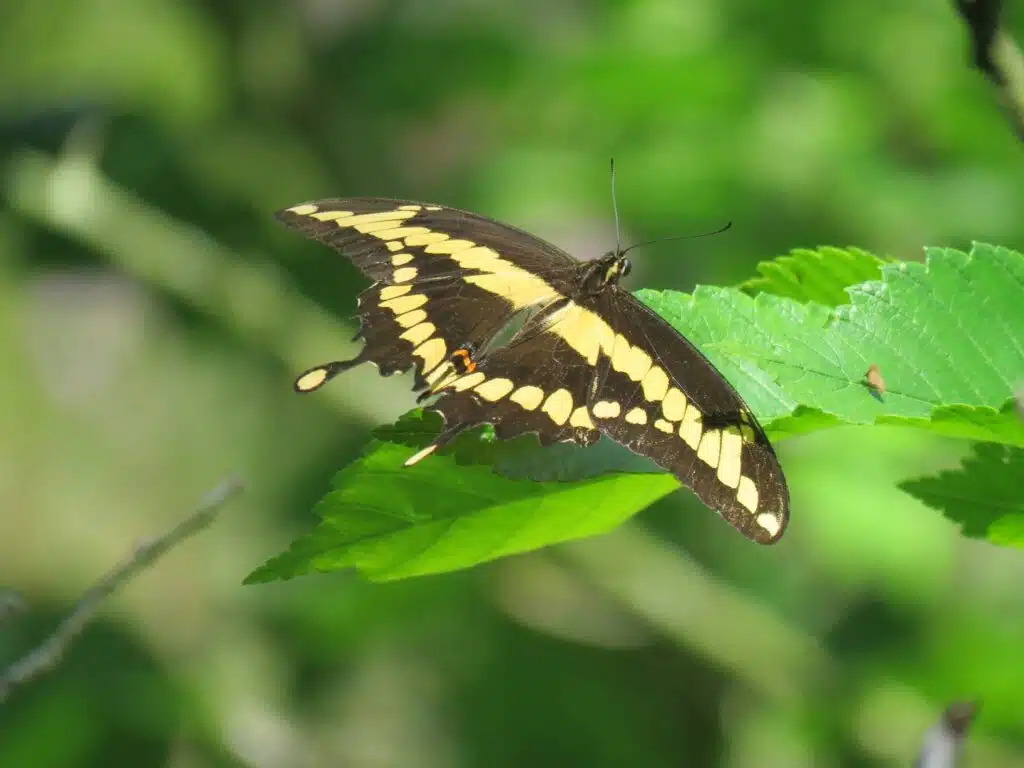
The Western Giant Swallowtail (Papilio rumiko) can be found throughout the southwestern United States, including Costa Rica, Panama, Mexico, and El Salvador. Their fore wings. grow to 5.8cm with two yellow bands on the fore wing and a central band made up of nine spots. There are also smaller yellow spots.
The background coloration of their wings is a dark spot, which can vary in size with a yellow central band. Their hind wings have two yellow bands that extend from the fore wing with an orange eye spot and a blue crescent. They have a yellow tail tip.
This beautiful butterfly lays its eggs singly on the young shoots and leaves of a host plant.
18. California Tortoiseshell
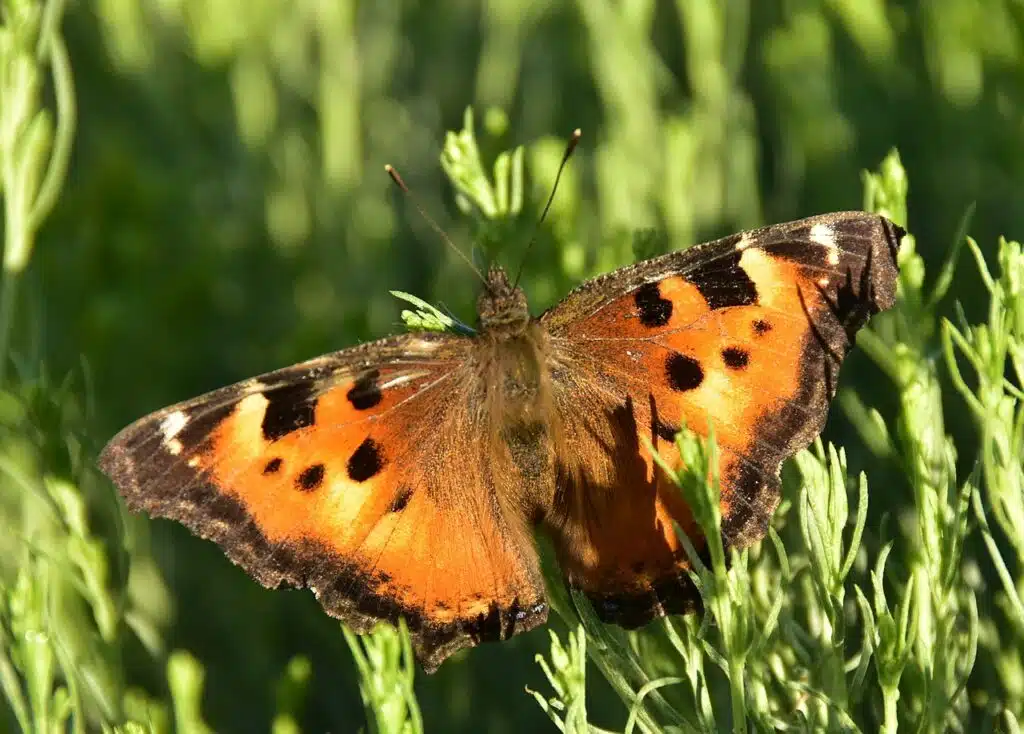
The California Tortoiseshell butterfly (Nymphalis californica) belongs to the Nymphalidae family and they have ragged edges to their wings. Their wings are orange with black spots, with a black margin. Below the wings are brown and they have a 7cm wing span.
The males wait in the late afternoons for females, where the eggs are then laid in batches on a host plant. They usually fly during spring, through to May, when they mate and lay eggs. As adults, they feed on flower nectar in woodlands, brush areas, forest edges, and clearings.
These butterflies are common from British Columbia to California and Montana to Mexico.
19. California Sister
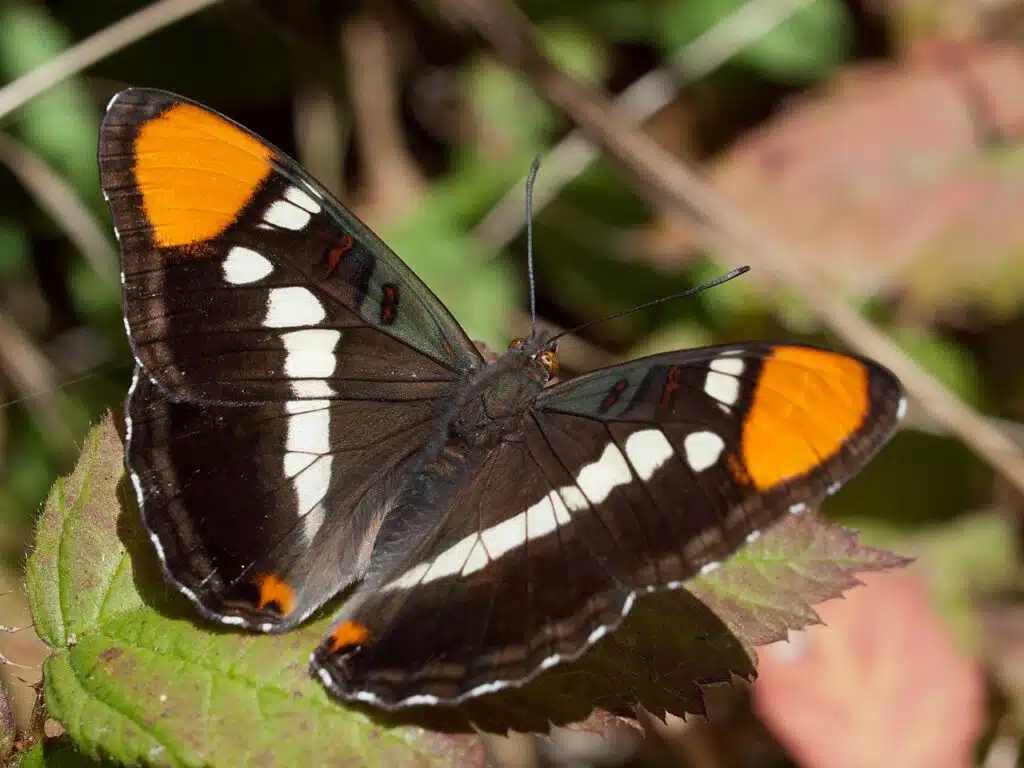
The California Sister (Adelpha californica) is common in California, though they can be encountered in Oregon and Nevada. They have dark brown wings with a cream band on both wings and two orange patches on the fore wings. Underneath, they are brown, orange, blue, and white.
These are large butterflies that can grow to 10cm in wing span. Adults are seen flying and perching near host plants in canyons that have water. They have up to three broods from March to October.
The adults enjoy rotting fruit and will sometimes feed on nectar from flowers in the fall. They are commonly encountered in foothills and mid-elevated mountains, woodland edges where there is water.
20. Mylitta Crescent
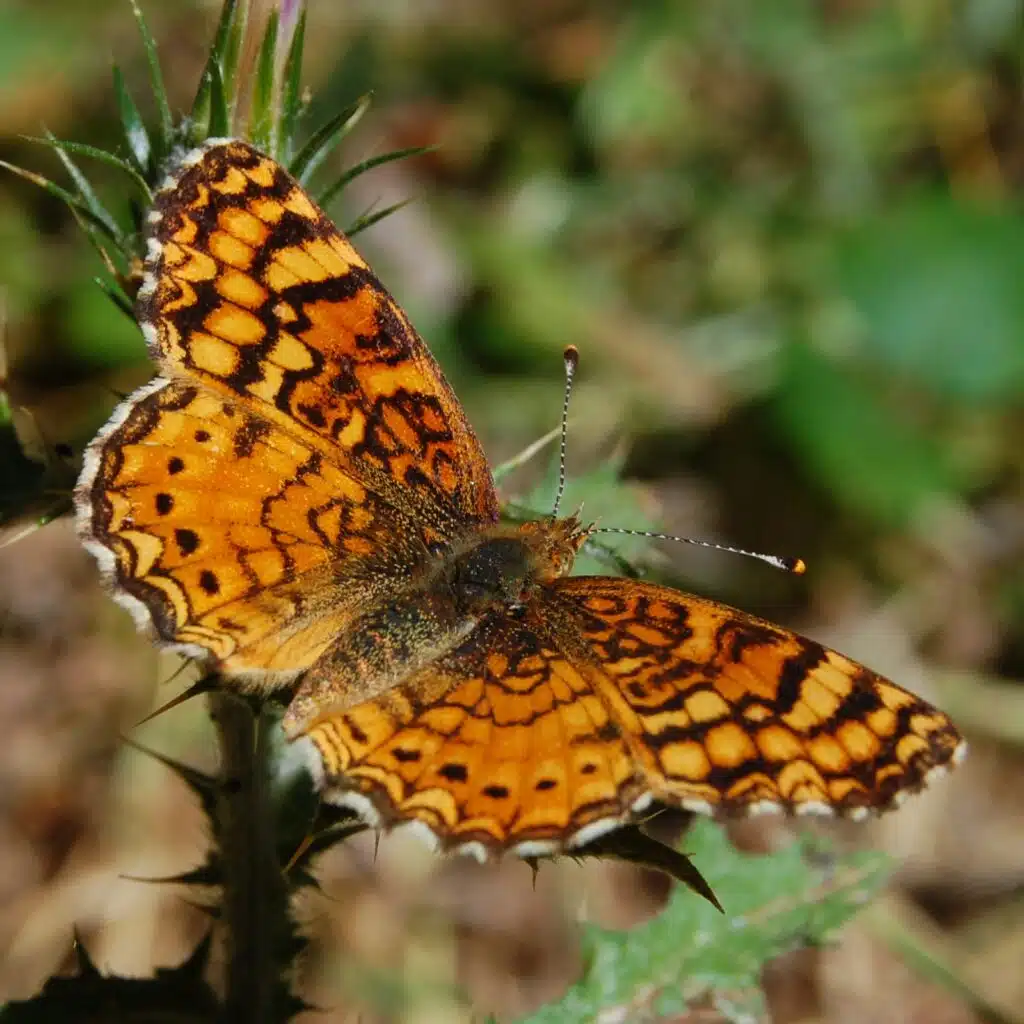
This butterfly (Phyciodes mylitta) is encountered in western North America with a 3.7cm wing span. These small butterflies have orange wings with black markings and a white bridge along the edges. The females are darker than the males.
They are more common from June to late July in Canada and from June until fall in California. You will find them in meadows, stream banks, and forested areas. As adults, they feed on flower nectar.
Males will patrol throughout the day searching for females, who deposit their eggs under the leaves of host plants. Once hatched, the caterpillars feed on the leaves. They fly from April to September and sometimes from February to November further down south.
These butterflies can be found from sea level up to high mountains, where they prefer roads, vacant lots, parks, and meadows. They are commonly found from British Columbia to the Rocky Mountains and Mexico to Washington, California, and Oregon.
21. Small Copper
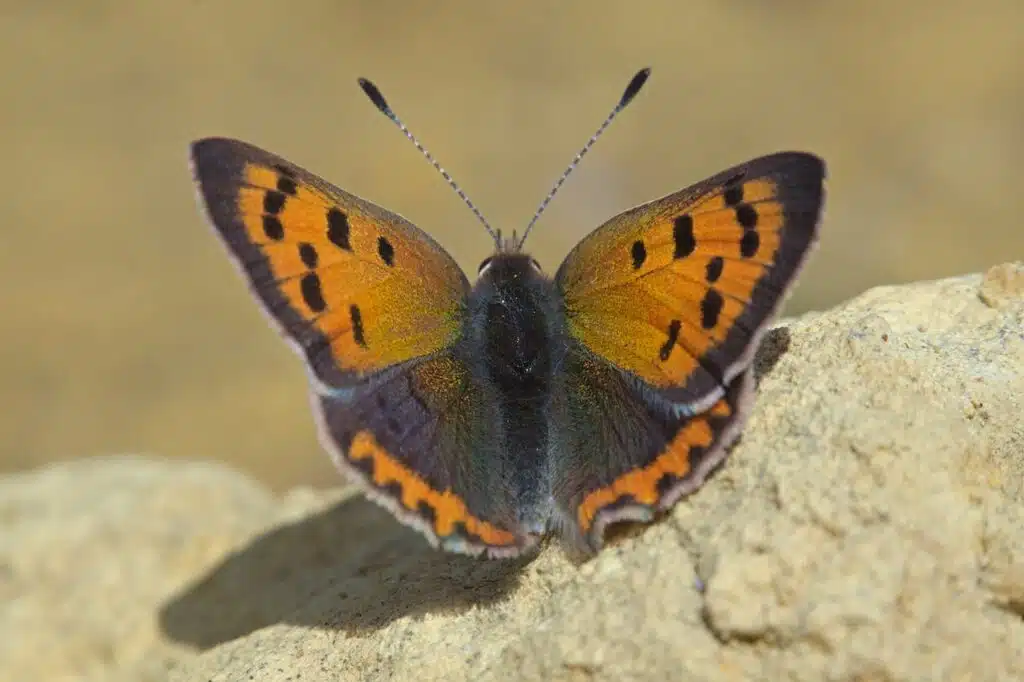
The Small Copper butterfly (Lycaena phlaeas) may be seen on its own or with a partner, sometimes they are seen in large numbers at good sites. Males are very territorial and will choose a piece of ground or store where they wait for a passing female. They are aggressive towards insects and will return to the same spot once they have chased the other insect away.
They are common butterflies that are small in size, growing to 3.5cm in wing span. These butterflies are an orange/red color with black spots with gray hind wings that have an orange outer margin.
They are most commonly encountered from July to September, where they feed on the nectar of flowers, preferring white clover and buttercups. They tend to choose disturbed places such as vacant loads, the edges of roads, fields, rocky outcrops, and pastures.
You can encounter the small copper butterfly from Canada to Georgia and North Dakota to Tennessee, Georgia, and Arkansas.
22. Northern Crescent
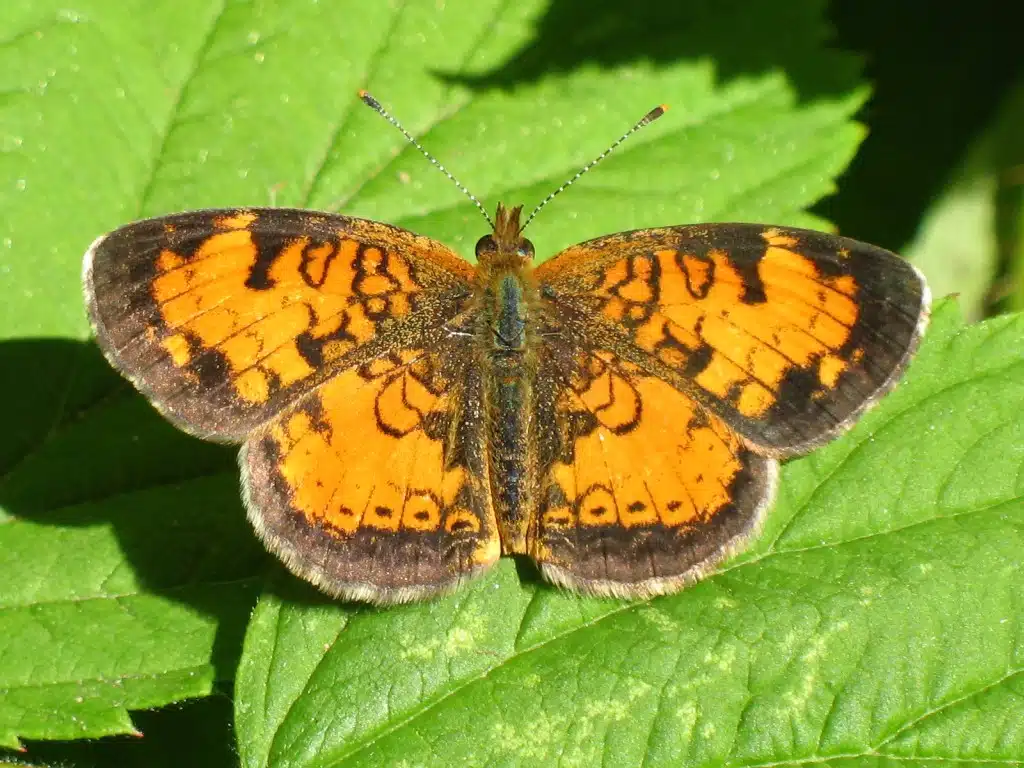
The North Crescent (Phyciodes cocyta) belongs to the Nymphalidae family with a wing span of 3.8cm. They are common from June and are found in fields, glades, woodland openings, and meadows. Females are darker than males, which is orange/brown with a dark border. Under their wings, they are orange with tan patches.
Males spend their days patrolling host plants waiting for a female. They feed on the nectar of white clovers, fleabane, and dogbane and are found in rocky places, close to streams, marshes, and shale barrens.
These butterflies can be found from Newfoundland to New England and southern Canada to British Columbia.
23. West Coast Lady
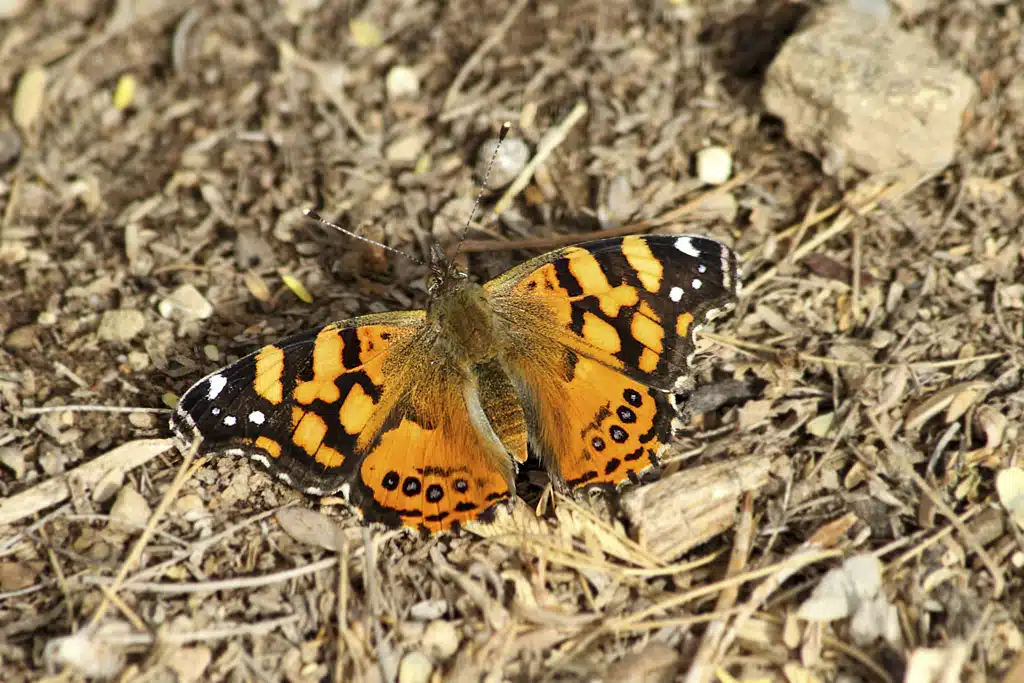
West Coast Ladies (Vanessa annabella) are one of the brush-footed butterflies in North America. They are seen throughout most of the Western United States and southwestern Canada. They are an orange/brown color with an orange bar on the edge of their fore wings.
These butterflies can grow to 5.7cm in wing span. The males wait for a receptive female will lay an individual egg on the leaf of a host plant. As adults they hibernate. Adults feed on the nectar of flowers and are seen in gardens, fields, foothills, and weeded areas.
The West coast lady can be found throughout Western North America from British Columbia to California and Colorado, Mexico, and Montana to North Dakota, central Kansas, and Southern Ontario.
24. Hobomok Skipper
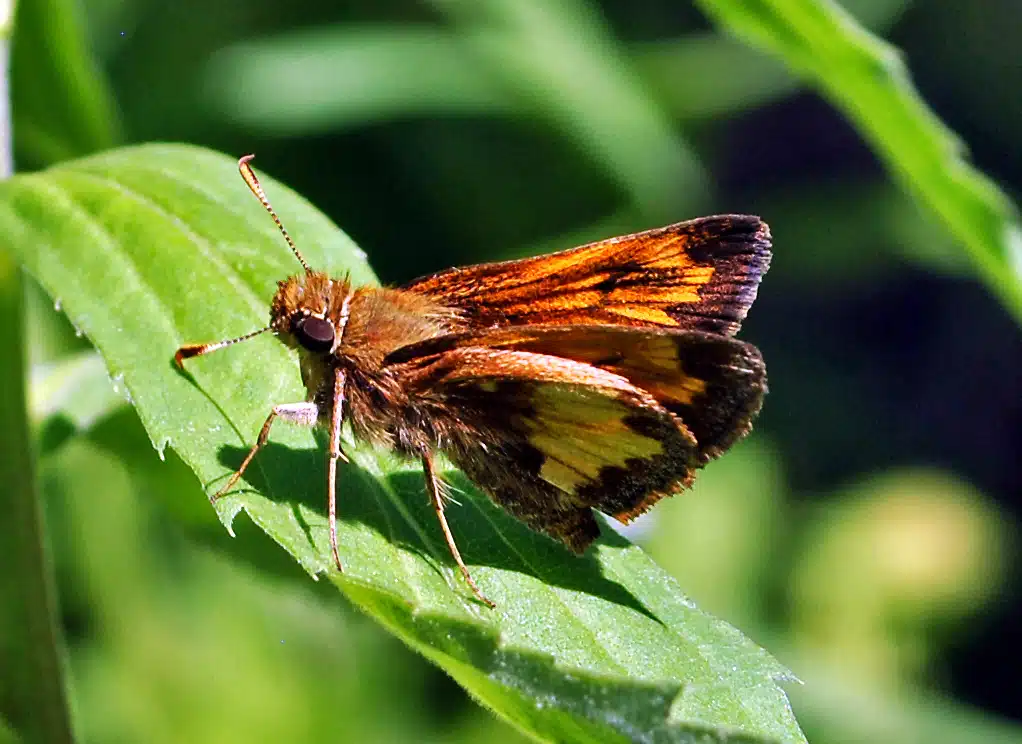
The Hobomok Skipper (Lon hobomok) has rounded wings with yellow to orange coloration and irregular black markings. Females come are dull and less orange than the males. These butterflies grow to a wing span of 4.3cm,
Males are usually seen perched high above the ground in woodland clearings waiting for receptive females, who then lay individual legs on host grass leaves, which are later eaten by the caterpillar. As adults, they feed on the nectar of milkweed, blackberry, and henbit.
They are often encountered at the edge of damp woods, bogs, and close to streams. Sometimes you may find them in a city park. They are found from Nova Scotia in Canada to Alberta, New Jersey, Georgia, Kansas, and Oklahoma. There are isolated populations in Colorado and New Mexico.
25. Field Crescent
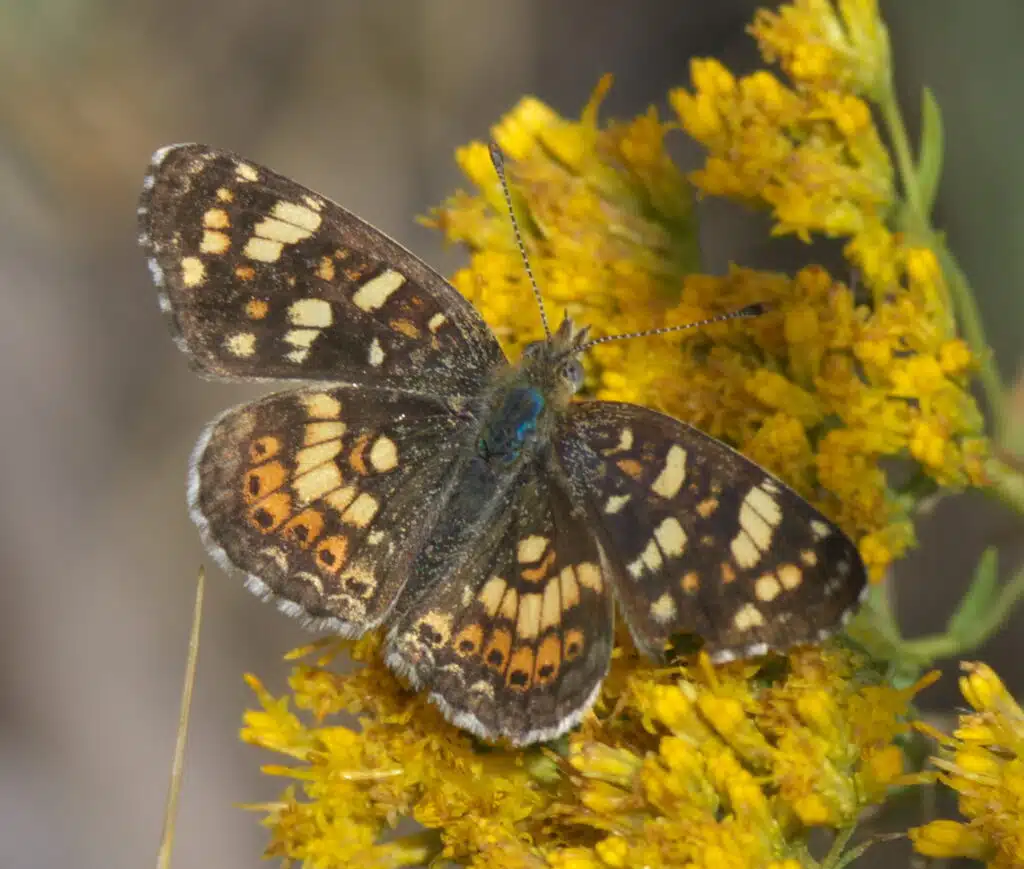
The Field Crescent butterfly (Phyciodes pulchella) belongs to the Nyphalidae family with a wing span of 4.5cm. This butterfly can be found from May to August. These orange and black butterflies have yellow to brown under their fore wing with a yellow bar and small black patches.
Under their hind wing, you will see a brown to yellow color with rusty-colored markings. The males fly above vegetation during the day searching for a female, she then lays her eggs in large batches under the leaves of a host plant. The caterpillars rely on the leaves as nutrition as they grow.
These butterflies feed on the nectar of flowers and are often seen in meadows, fields, mountains, and plants, along with any flat and open area. They are common from southern California to Arizona, New Mexico, and on the western edge of the Great Plains.
26. Meadow Fritillary
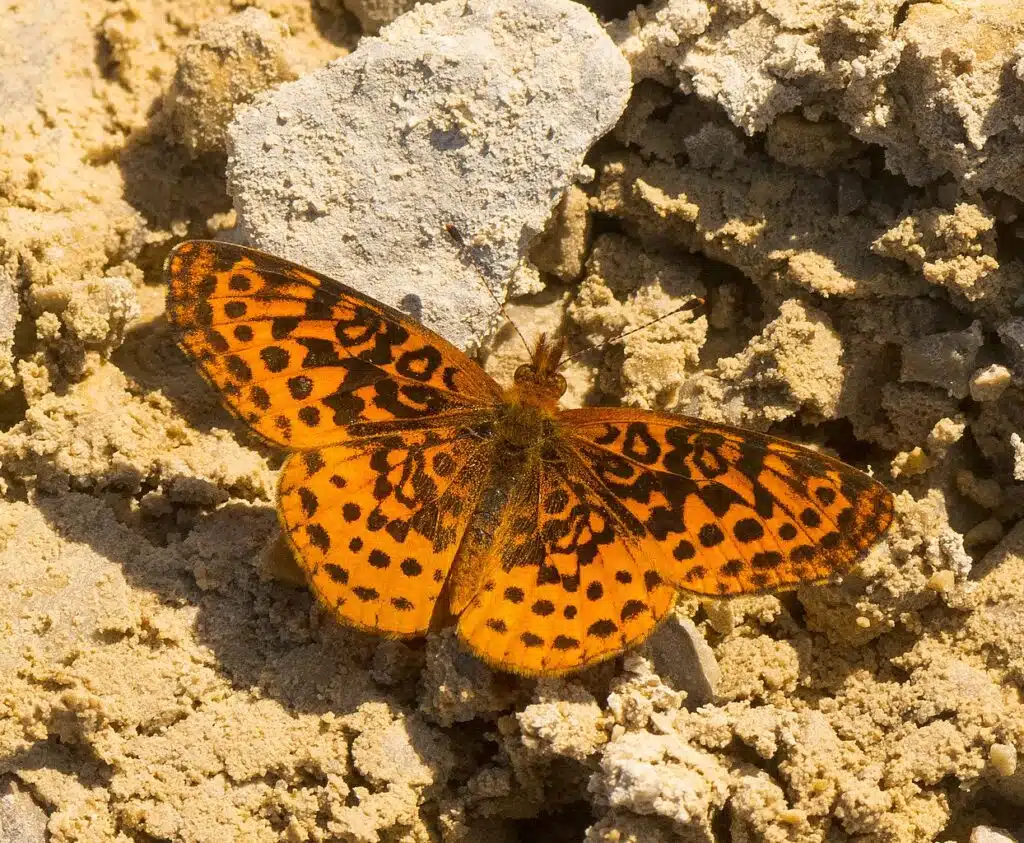
The Meadow Fritillary (Boloria bellona) has a squared fore wing, which is orange to red with black markings. Underneath the hind wing is a pattern of orange and purple-brown with a white patch and silver spots.
These butterflies can grow to 5.1cm in wing span and the males are seen in meadows searching for a female during warm daytime hours. They are commonly encountered from April to mid-October when they feed on the nectar of black-eyed Susan and dandelions.
The meadow fritillary prefers damp habitats, including wet aspen groves and mashes. They can be found from Oregon and central Colorado to Tennessee and North Carolina. They are adapting to disturbed areas and are expanding their range towards the south.
27. Behr’s Metalmark
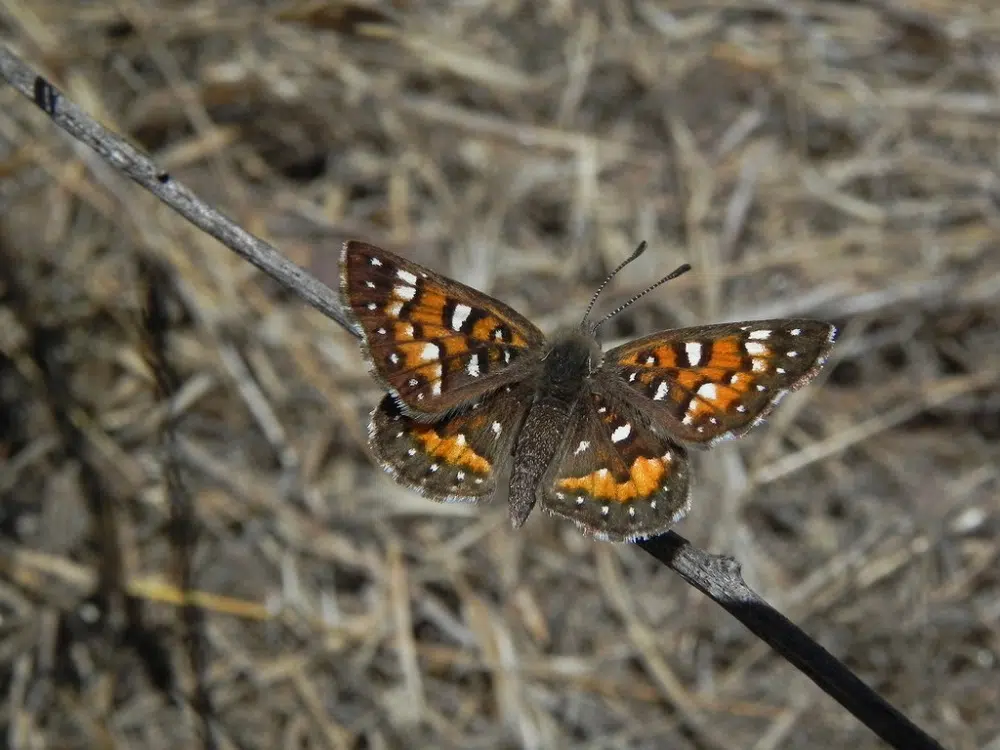
This butterfly (Apodemia virgulti) has a red/orange/brown upperside with black and white spots. There is an orange spot on both wings. Under the wings is gray with white spots and under the fore wing is an orange patch. These butterflies grow to 2.4cm and are small butterflies.
The male spends its day hiding inside hill hollows waiting for a female, who then lays groups of eggs on the lower leaves of the host plant. These butterflies can be seen from March to September and all year round in San Diego.
The adults feed on flower nectar where they live in a range of habitats in California.
28. Baltimore Checkerspot
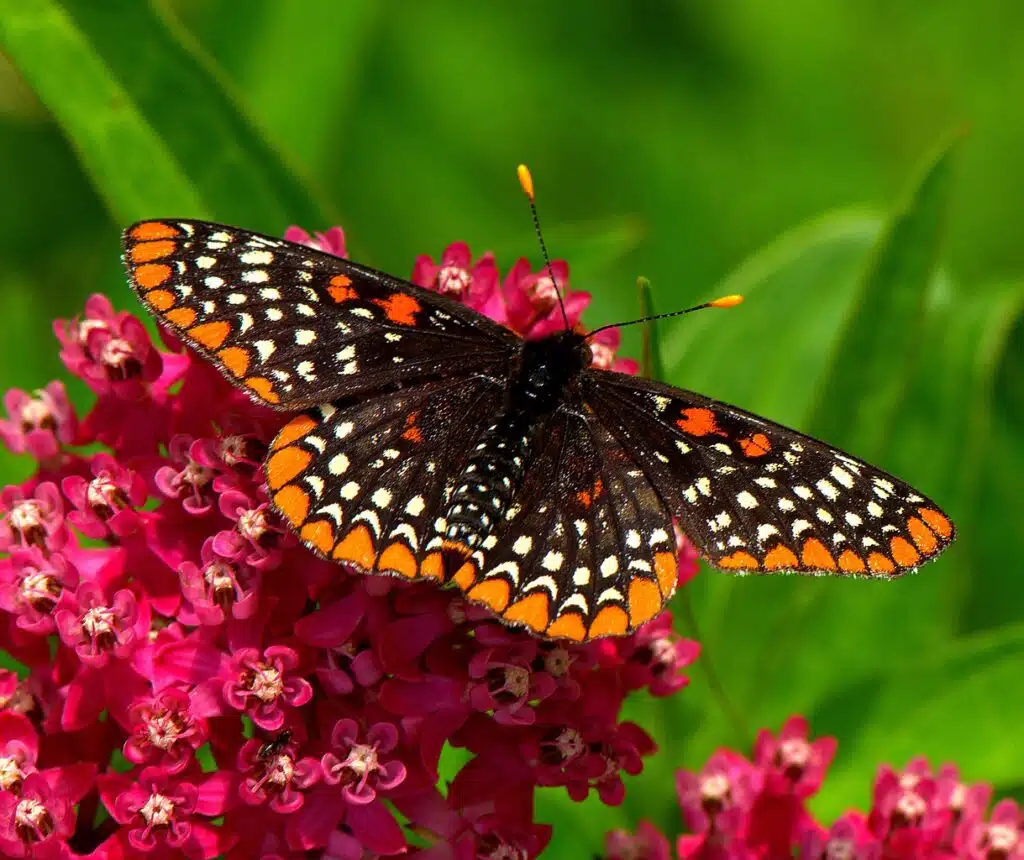
The Baltimore Checkerspot (Euphydryas phaeton) is back with orange crescents with cream to white colored spots in rows on both wings. They grow to 7cm in wing span and are common from June to August in the north and May to June in the south.
These butterflies feed on milkweed, wild rose, and viburnum nectar in bogs, marshes, and wet meadows, though they can be found in dry and open hillsides in the southwest. You may find one of these butterflies in northern Georgia, northern Mississippi, Texas, Nebraska, and northeast Oklahoma.
29. Northern Checkerspot
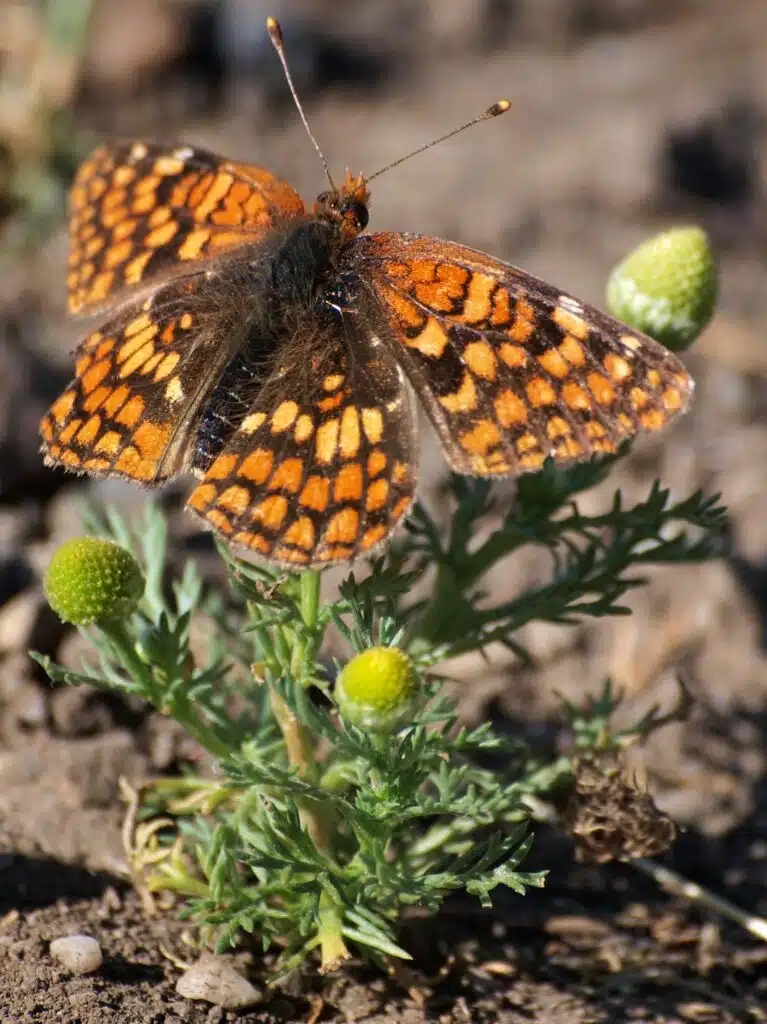
The Northern Checkerspot (Chlosyne palla) is a brown to red butterfly with dark hind wings. Under their wings, they are orange with cream bands. Females are similar but they have white spots. These butterflies grow to 4.8cm in wing span.
The males perch and fly in valleys close to the host plans waiting for females. She lays her eggs in the ground, under the leaf of a host plant, which is food for the caterpillar once it hatches. They are common from April to July in mountainous and northern areas and from April to May in coastal California.
They prefer open woodlands, stream edges, chaparrals, and sagebrush where they feed on the nectar of flowers. You can find these butterflies in southern California and south through to the Rocky Mountains to Colorado and Utah.
30. Milbert’s Tortoiseshell
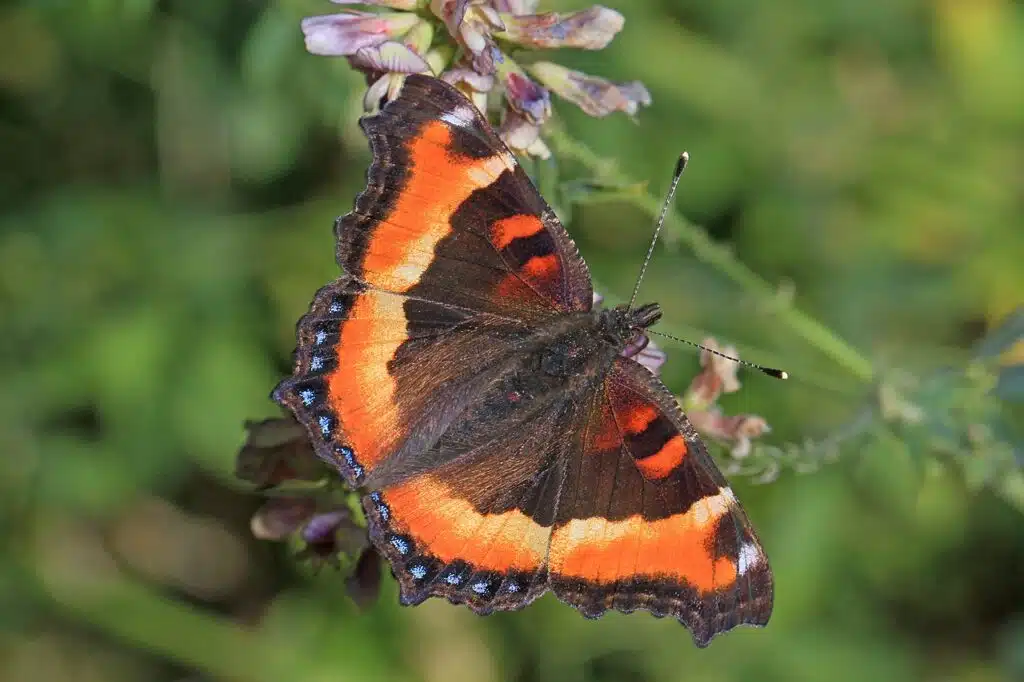
Milbert’s Tortoiseshell butterfly (Aglais milberti) has squared-off fore wings. They are black with a wide orange band, which changes to yellow in the inner half. There is a black border on both wings. Some have blue spots on the border of the hind wing. They can grow to 6.3cm in wing span.
The males spend their afternoons searching for females. She lays large batches of up to nine hundred eggs on the underside of the host plant’s leaf. They are mostly seen from May to October, feeding on the nectar of thistles, lilacs, and goldenrods, along with sap and rotting fruits.
These butterflies prefer damp areas and are mostly encountered in marshes, woodlands, and wet pastures. They can be found from California to Nevada and New Mexico to West Virginia.
31. Atlantis Fritillary
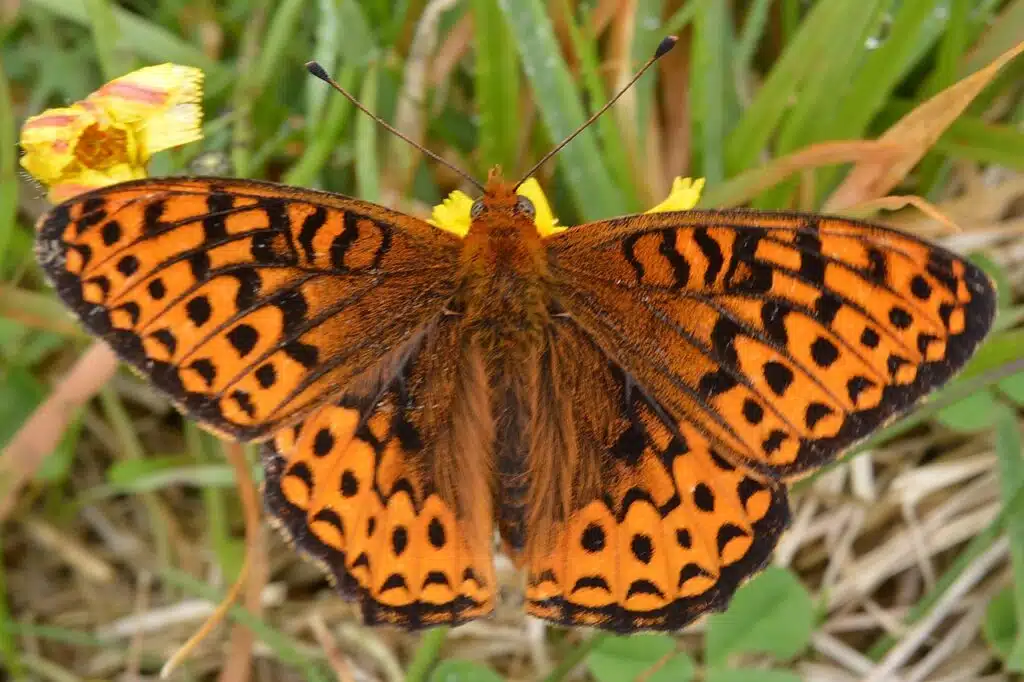
This butterfly (Speyeria atlantis), which is commonly seen from June to September is variable in color. They are often an orange color with a dark base and black margins. Under their wings, they are chocolate brown with silver spots on the hind wings. They can grow to 7cm in wing span.
These butterflies lay individual eggs on leaf litter, close to the host plants. As butterflies they prefer feeding on the nectar of common milkweed, mountain laurel, mints, and crown vetch, to name a few. They can be found from West Virginia to the Great Lakes and the Rocky Mountains to Colorado.
32. Julia Heliconian
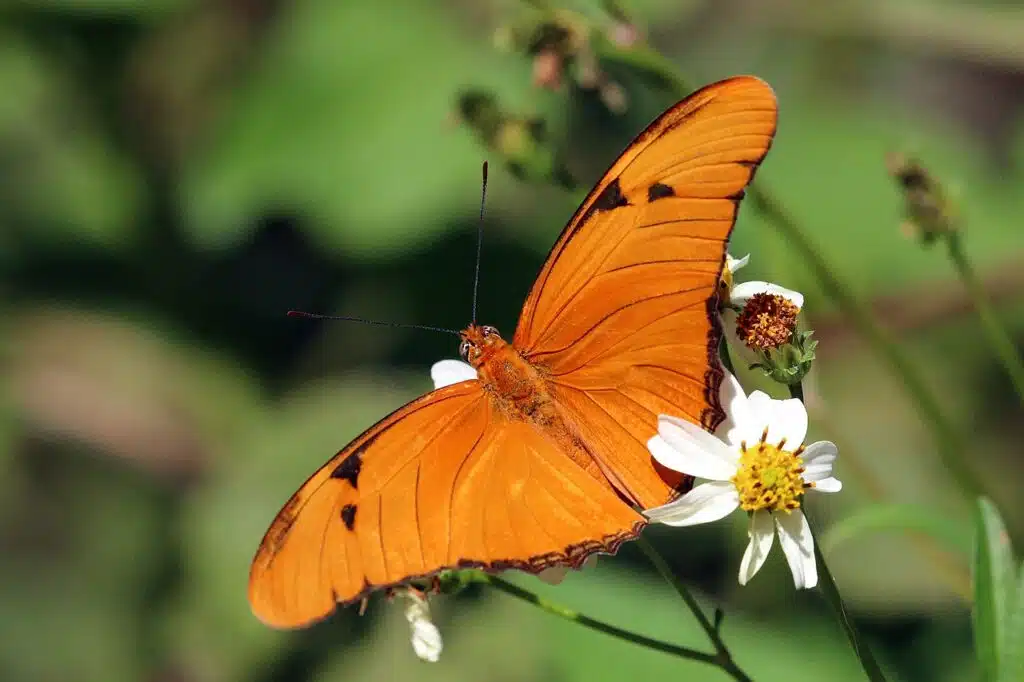
The Julia Heliconian (Dryas iulia) has elongated fore wings. with males being bright orange, both above and below their wings. The hind wings have a black border. Females are less colorful and have more black markings. They can grow to 9.2cm in wing span, making them large butterflies.
These butterflies are seen throughout the year in South Texas and southern Florida and during the summer months higher north. They feed on flower nectar and prefer living in fields and subtropical hammocks.
They are found in Central America, Mexico, Florida, eastern Nebraska, and southern Texas.
33. Broad-winged Skipper
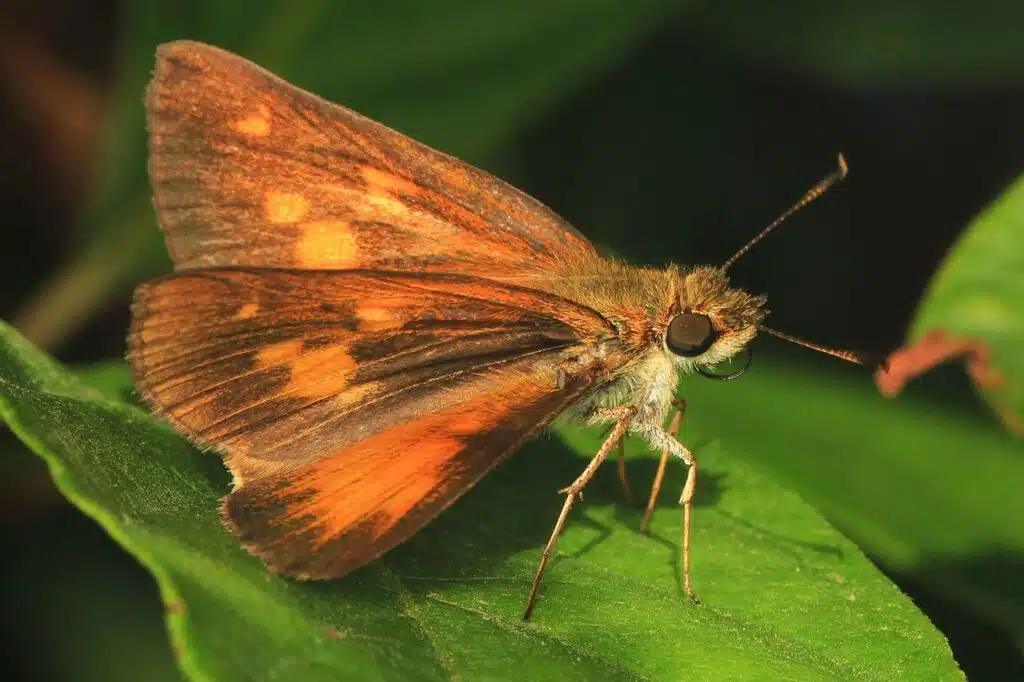
The Broad-winged Skipper (Poanes viator) has rounded forewings. that are dark brown with orange areas and cream spots. The hind wings are orange with a black border, along with black veins. Under their wings is orange-brown with yellow/orange streaks.
These butterflies grow to 5.7cm in wing span and are commonly seen from May to August in Texas, June to August inland, and July to August along the Atlantic Coast. The inland populations tend to feed on the nectar of milkweed and blue vervain, while coastal populations prefer swamp milkweed, thistles, and fleabane. They can be found near fresh and saltwater marshes.
34. Aphrodite Fritillary
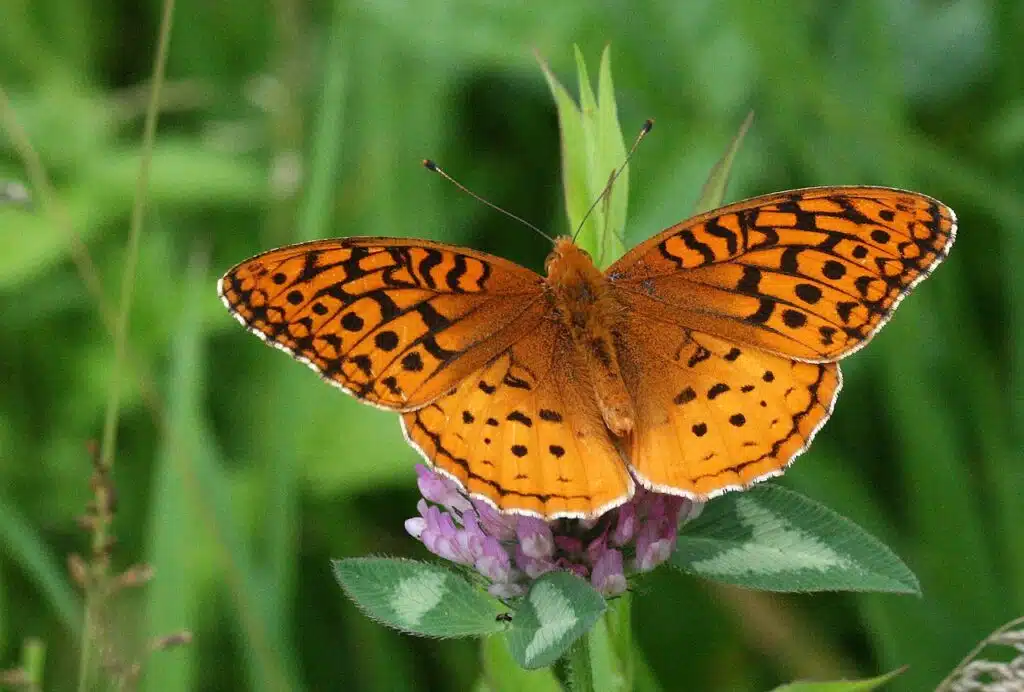
The Aphrodite Fritillary (Speyeria aphrodite) is variable based on its location. They are red to orange/brown with males having a black spot on their wings. Under their wings is a pale band. They are large butterflies growing to 8.3cm in wing span.
The females lay their eggs on the ground, close to violet plants. The caterpillars then eat the young leaves of the plant. They are commonly seen from June to September when they feed on the nectar of milkweed and viper’s bugloss.
This butterfly can be found from the Great Plains to the Rocky Mountains and Arizona to Georgia and New Mexico where they prefer prairies, barrens, brushlands, open oak woods, bogs, meadows, and dry fields.
35. Satyr Comma
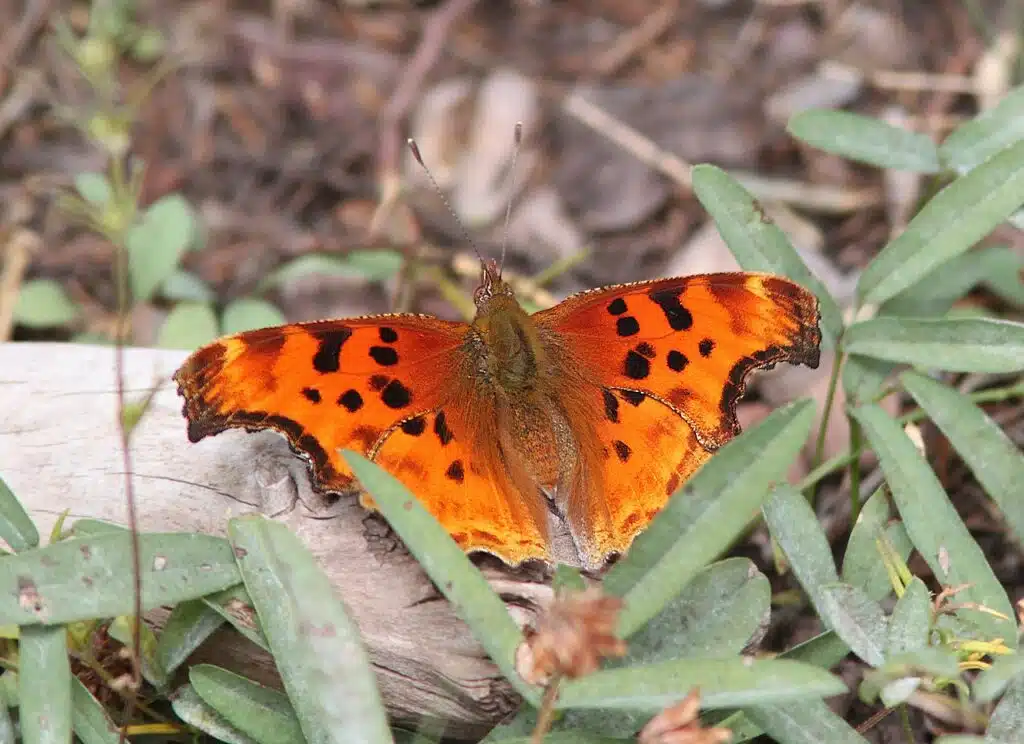
These beautiful butterflies (Polygonia satyrus) grow to 6.4cm in wing span and have bright orange to yellow forewings. with two black spots. The hind wings have a black spot in the center of the wing. They are golden brown under their wings.
The female lays single eggs under nettle leaves where the caterpillars then eat the leaves to help them grow. As adults, they hibernate and are seen flying from February to November along the Pacific coast and from July to September across Nevada and its surrounds.
As butterflies, they have a varied diet, which includes rotting fruit, flower nectar, and tree sap. They are commonly encountered in the bottom of valleys, wooded prairie ravines, riparian woods, moist woods, and along streams.
36. Vesta Crescent
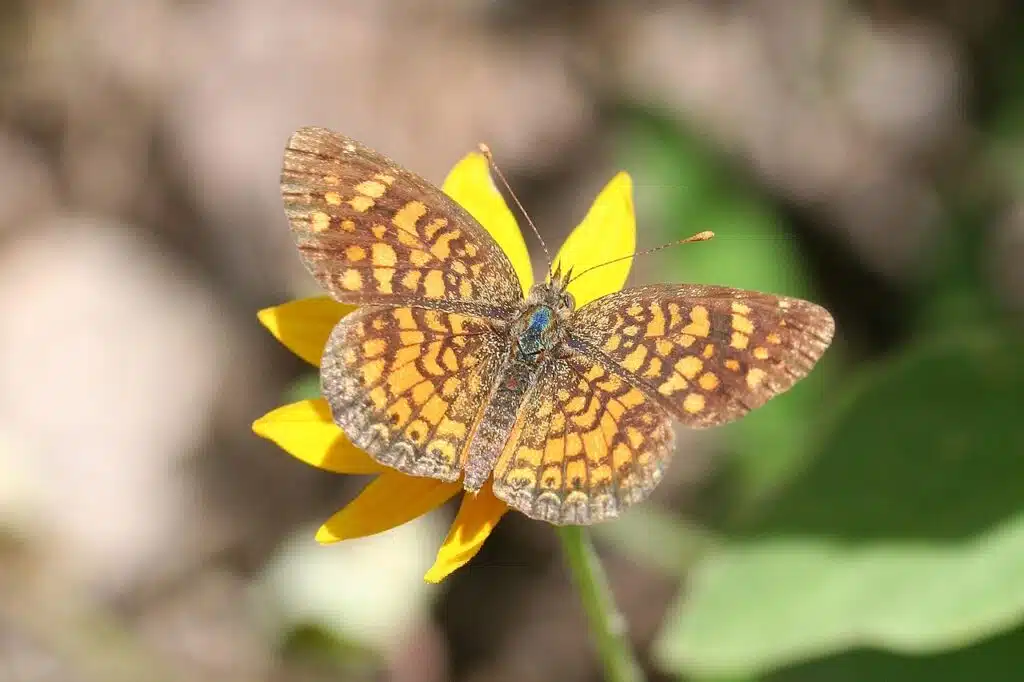
The Vesta Crescent butterfly (Phyciodes graphica) has orange wings with black lines. They can grow to 3.8cm in wing span and are mostly seen from February to December in southern Texas and April to September in the north. They are encountered throughout the year in Mexico.
They are mostly encountered in deserts, prairies, road edges, streambeds, and thorn woodlands from Guatemala to Mexico and Arizona to Texas, Colorado, Nebraska, and Arkansas where they feed on the nectar of flowers.
37. Mormon Fritillary
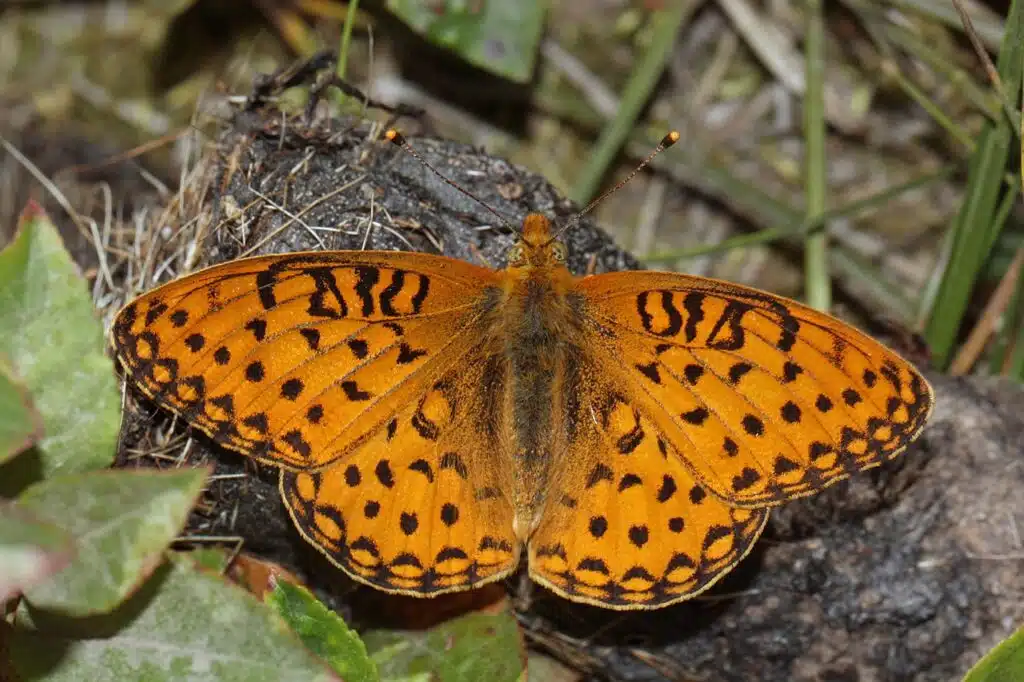
This butterfly (Speyeria mormonia) grows to 6.1cm in wing span and is orange-brown with an orange to brown underside to their hind winds. They are commonly encountered in mountain meadows, prairies, valleys, and forest openings from June to September.
The Mormon Fritillary is found from California to Arizona and Nevada to New Mexico.
38. Edith’s Checkerspot
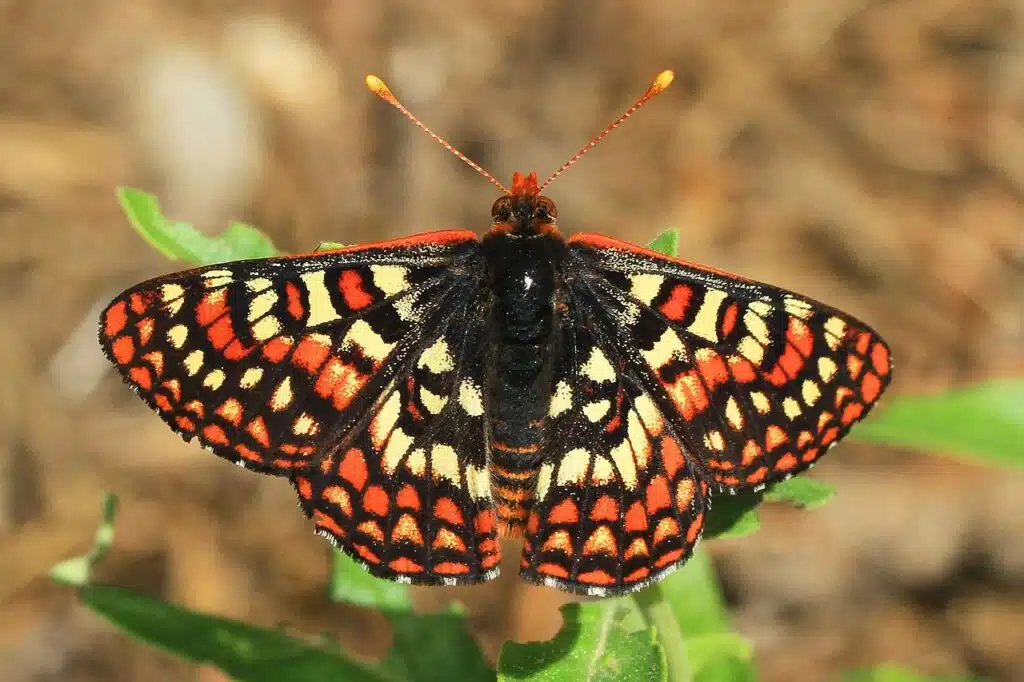
The Edith’s Checkerspot butterfly (Euphydryas editha) has a rounded tip to their fore wing. The wings are black with pale yellow to orange or white banding. Under their hind wing, they are bands of orange and cream. They can grow to 5.1cm in wing span.
They are usually encountered from March to May in low elevations and from June to August in the north or at high elevations where they feed on the nectar of flowers in coastal chaparral, fields, foothills, meadows, alpine fields, and open woods. They can be encountered in Utah, Colorado, Nevada, and Baja California.
39. Bronze Copper
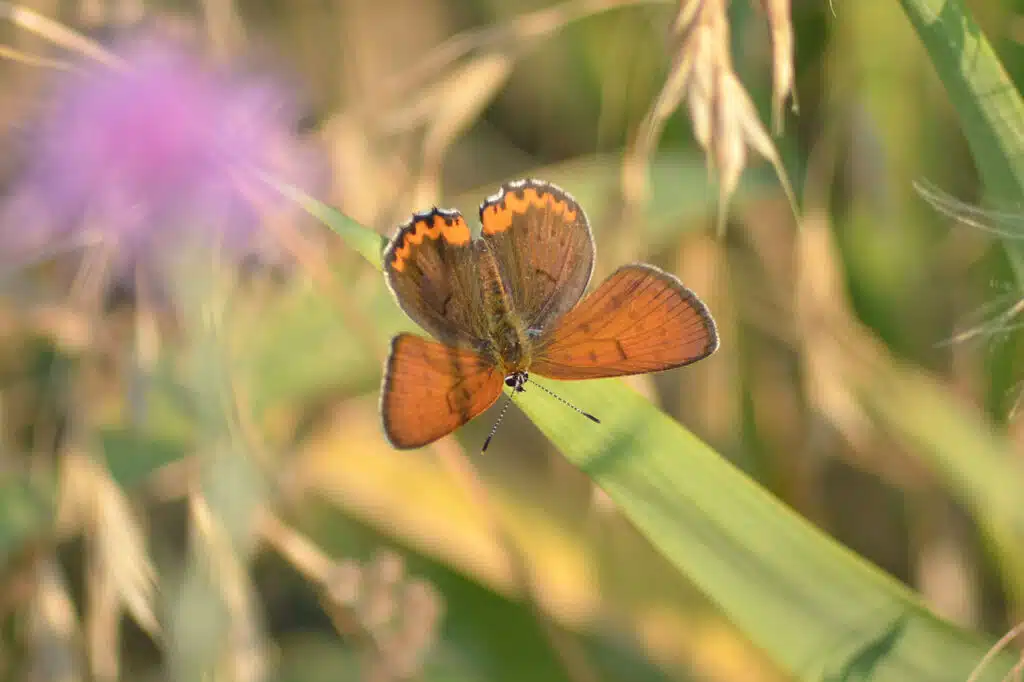
The Bronze Copper butterfly (Tharsalea hyllus) is common from Maine to southern Canada and eastern Montana to Colorado, Mississippi, Maryland, West Virginia, and Arkansas.
These butterflies grow to 4.8cm and the males are copper brown. Females have orange forewings. with black spots.
The males wait close to the host plant for a female, where she then lays eggs one at a time on plants. The eggs hibernate until spring when the caterpillars then eat the leaves. These butterflies are more common from May to November in the south and June to September in the north and west.
They prefer low-lying wet areas, which include ponds, wet meadows, bogs, and marshes where the adults eat the nectar from red clovers and blackberry plants.
40. Callippe Fritillary
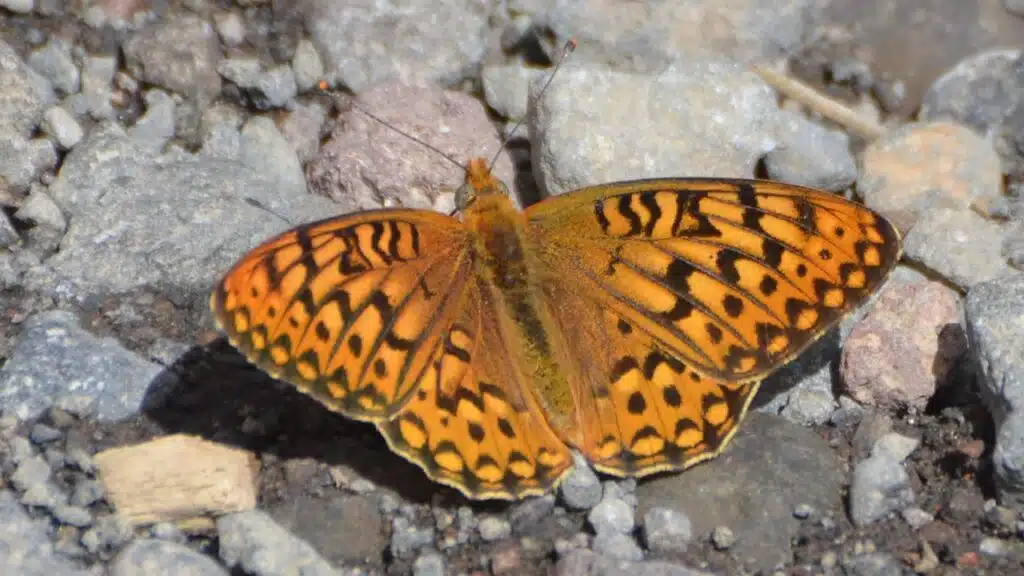
The Callippe Fritillary butterfly (Speyeria callippe) is tawny to bright red/orange on the upper side of the wings with evenly spaced marketings. Underneath they have silver triangular-shaped spots and narrow edging in brown. They can grow to 6.4cm in wing span.
These butterflies are common in dry woodlands, prairie hills, sagebrush, and chaparral from South Dakota to southern California, Utah, Nevada, and Colorado.
There is some concern regarding the conservation status of these butterflies, where they are considered threatened with extinction in San Francisco Bay, making them vulnerable to extinction.
41. Gorgone Checkerspot
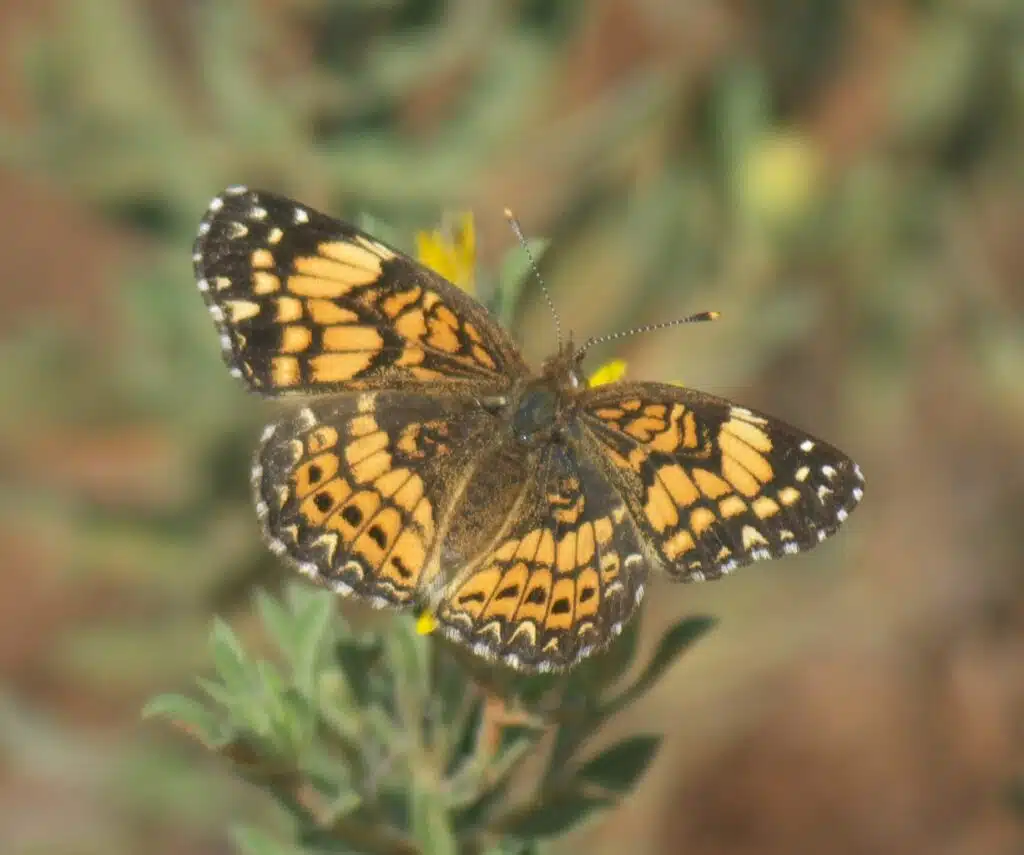
The Gorgone Checkerspot (Chlosyne gorgone) is orange with black markings and its hind wings have a row of solid black spots. Under their hind wing is a brown zigzag pattern with white bands.
They grow to 4.5cm and fly from July to August in the north and from May to September in the central areas. You can see them from April to September in the south.
These butterflies tend to prefer the nectar of yellow flowers in open areas, which includes hardwood forests, forest edges, old fields, and prairies. You can find them from New Mexico and central Texas to Georgia and Louisiana. There are also some isolated populations in the Rocky Mountains.
42. Silver-bordered Fritillary
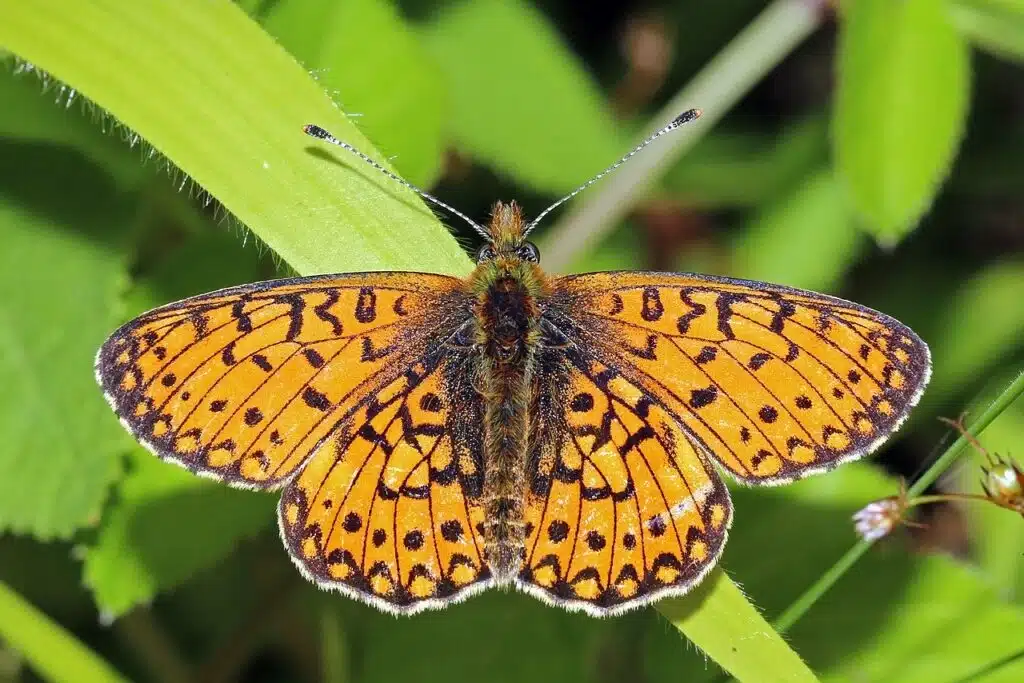
The Silver-bordered Fritillary butterfly (Boloria selene) is black and orange and grows to 5.4cm in wing span. These butterflies can be seen from May to September in the east and June to July in the north. They prefer the nectar of composite flowers, which include black-eyed Susans and goldenrods.
They are commonly encountered from central Washington to the Rocky Mountains and Illinois, Maryland, and Virginia to New Mexico where they can be seen in bogs, marshes, and wet meadows.
43. Green Comma
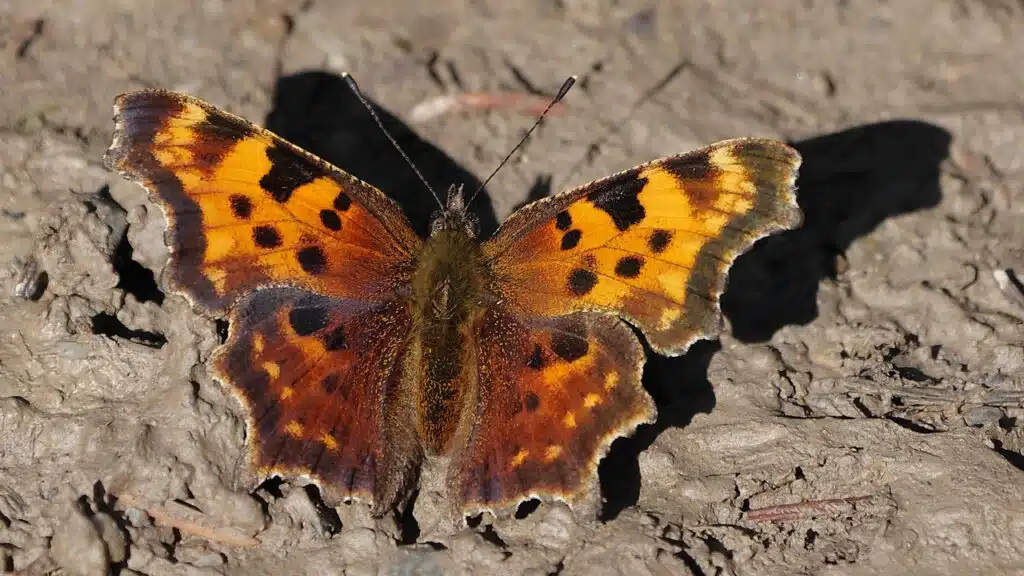
The Green Comma butterfly (Polygonia faunus) has ragged edges on its wings with a red/brown coloration with dark borders. The hind wings have yellow spots. They can grow to 6.4cm in wing span and are common from May to August.
They can be found in forests, canyons, and the side of streams in mountains from New England to the Great Lakes. They feed on the nectar of flowers and dung.